
2


A ship’s Pilot has the training and expertise to guide a wide variety of vessels, including the world’s most massive oil tankers, modern container ships, and luxury cruise liners, into and out of the intricate complex of narrow channels, shallow waters, currents, hazards, and local marine traffic to ensure safe passage.
“STEADY as she GOES”

–CAPTAIN JACOB A. JACOBSEN

From the day, more than a century ago, when Jacob A. Jacobsen arrived in Long Beach, the story of the company he created is one of steady progress.
Like the ships he and his Pilots steered into port, he guided the company’s growth with a steady hand and a keen sense for making the right moves at precisely the right moment.
DEDICATION
The Jacobsen family dedicates this book to the truly amazing past and present employees who have made Jacobsen Pilot Service successful.
The collective efforts of each of you, past and present, has resulted in a culture of superior service, maintaining the highest standards of professional conduct in what is certainly among the most challenging jobs in the maritime world. It is remarkable to realize that we, as an organization, have now been in service 24 hours a day, nonstop since 1924, safely piloting ships, operating pilot boats, dispatching, and running the administration.
Not only do we recognize our dedicated employees, but also their families. Working a 24/7 business that never stops, not even for holidays, takes incredible support from the families, and we truly appreciate the many sacrifices made over the years.
The following history of Jacobsen Pilot Service emphasizes milestones in the evolution of the company from its humble origins more than a century ago. And while many personalities were involved, and there are many individuals who deserve recognition for their specific contributions, it really took all of us, working together, to accomplish this remarkable history.
Our company is unique, especially today, with most employees having a successful career over a 30-year span—and many even up to 40 years of employment. As we enter our second century, we’ll continue each day to follow the vision of my Grandfather and Father: teamwork, continual improvement, and a commitment to superior service.
–Thomas A. Jacobsen

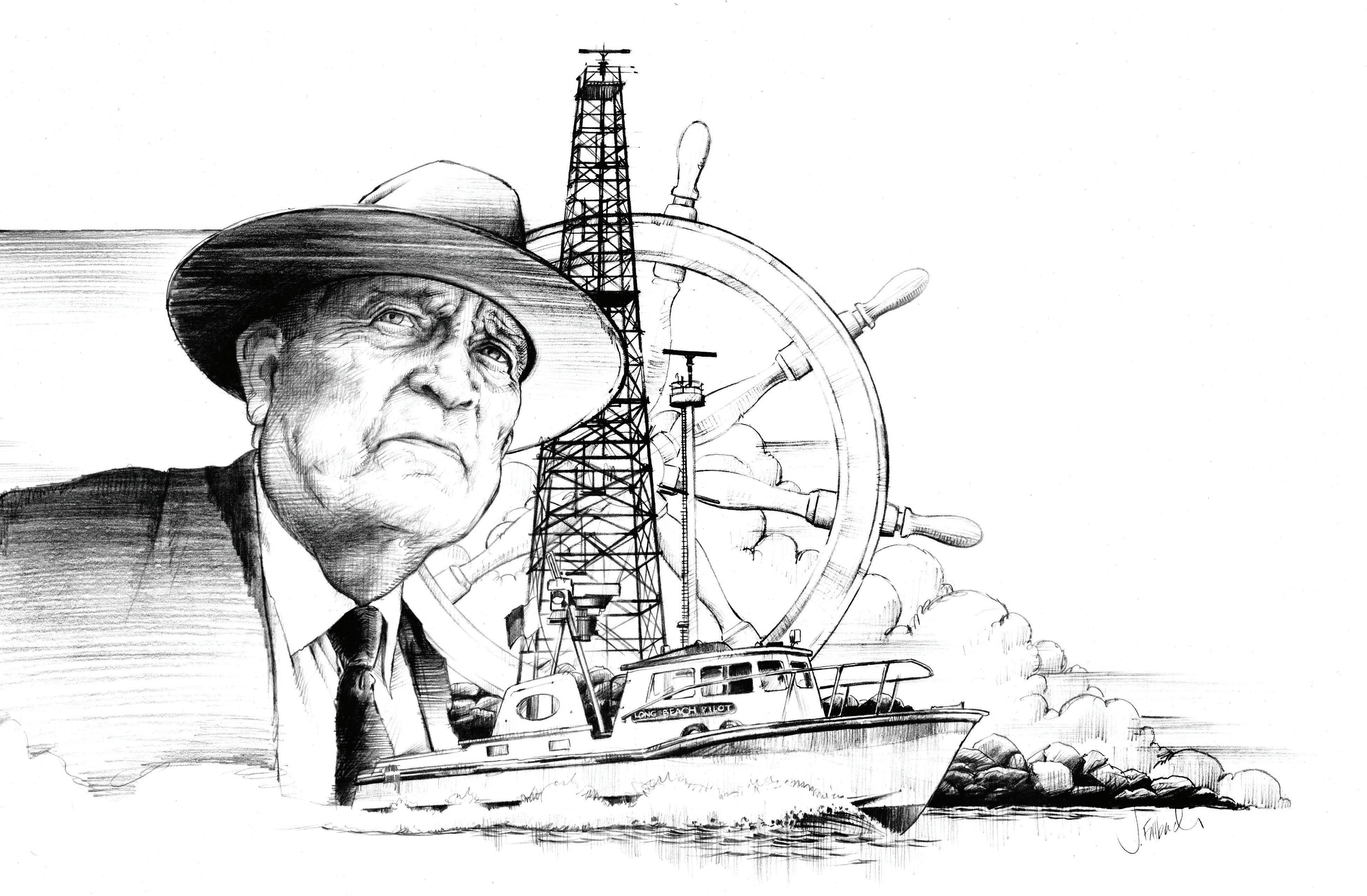

CHAPTER I Climbing the Ladder 8 CHAPTER II The Early Years 14 CHAPTER III To Grow and Grow Alike 18 CHAPTER IV Richard Jacobsen, CEO: 1960–1998 26 CHAPTER V Tom Jacobsen, CEO: 1998–Present 38 CHAPTER VI Maintaining the JPS Standards 48 CHAPTER VII All Employees Are Family 50 CHAPTER VIII A Day in the Life of a JPS Pilot 52 CHAPTER IX Our Flagships Are Small but Mighty 54 CHAPTER X The Next Years 60 CHAPTER XI Letter of Appreciation 62 CONTENTS
CLIMBING THE LADDER
The Rise of Young Jacob Jacobsen
Looking back to the Norwegian fishing village where he was born, nothing about the life of Jacob Jacobsen was inevitable. He could easily have remained among his people and lived as the local fishermen of tiny Mindland Island had for hundreds of years, but his life unfolded at a time of profound change. Born in 1890, he came of age at the dawn of the 20th century, when the ‘New World’ promised a better life.
In the Old World of Scandinavia, ancient political structures were shifting. In 1905, Norway dissolved its union with Sweden and the Swedish Royal Family, only to have a Danish Prince be chosen Norway’s new sovereign. It must have been clear even to a young Jacob Jacobsen that his native Norway would not soon be the master of its own fate.

8
CHAPTER
1
All dressed up for the American Dream: Jacob A. Jacobsen (left) and his cousin John.

In 1904, at the age of 14, Jacob had begun work as a deckhand aboard a small vessel plying the west coast of Norway. Now, using what would become his special gift, he read the winds and undercurrents of the situation around him and charted his own course.
He had an uncle who had left Norway for a farm in North Dakota, and Jacob and his cousin John made plans to join him. The decision to leave home at 18 could not have come easily. Uncertainly, unfamiliarity, language, and logistics all posed obstacles—but from such challenges character is forged.
9

THE LAND OF OPPORTUNITY IS THE SEA
Arriving in America in 1906, Jacob quickly trades farming for a life at sea.
Jacob and his cousin John boarded a ship bound for New York Harbor and Ellis Island. A train took them to the uncle’s farm on the bleak Dakota plains. However, after just a few months, Jacob heard the sea calling. Making his way to Seattle, he signed on as a deckhand aboard a stern-wheeler operating on Puget Sound. At 19, he shipped out on a Gloucester schooner to fish for cod and halibut off Alaska.
From there, he joined a whaling company, working the icy waters of the Aleutian Islands and he soon found himself being made Captain of a whaling ship.
By 1914, he was now 24 and had gained extensive experience at sea, having sailed all types of ships in all manner of seas. Back in Seattle, at the Federal Courthouse, he was sworn in as a naturalized American citizen. Soon after, he signed up to serve his new country in the United States Navy.
In Europe, WWI erupted that summer. Norway, ironically, managed to remain neutral, keeping its shipping lines and port cities out of the hands of either the Germans or the British.
Taking note of Jacob’s decade of life at sea, the U.S. Navy made him Lieutenant Jacobsen and he was assigned as a Navigator aboard troop transports and freighters carrying soldiers and supplies to front lines in France.
When the war ended, he joined the Sturzen Berry Line, which carried cargo on the “China Run” as well as ports throughout Asia-Pacific.
Decades later, Long Beach would become a major port on the West Coast, serving ships from around the world that were guided into port by Jacobsen Pilots.
10
CHAPTER 1

Born: July 1, 1890, in Mindland, Norway. ��
Jacob Andrew Jacobsen is born in Mindland, a small island near the Arctic Circle, with an agricultural and fishing community. There was no access to mainland other than by boat.

Bound
for
Ellis Island on the RMS Oceanic.
August 25, 1909, at age 19 with his cousin John. RMS Oceanic 1899 was a transatlantic ocean liner built for the White Star Line and was the largest ship in the world until 1901.
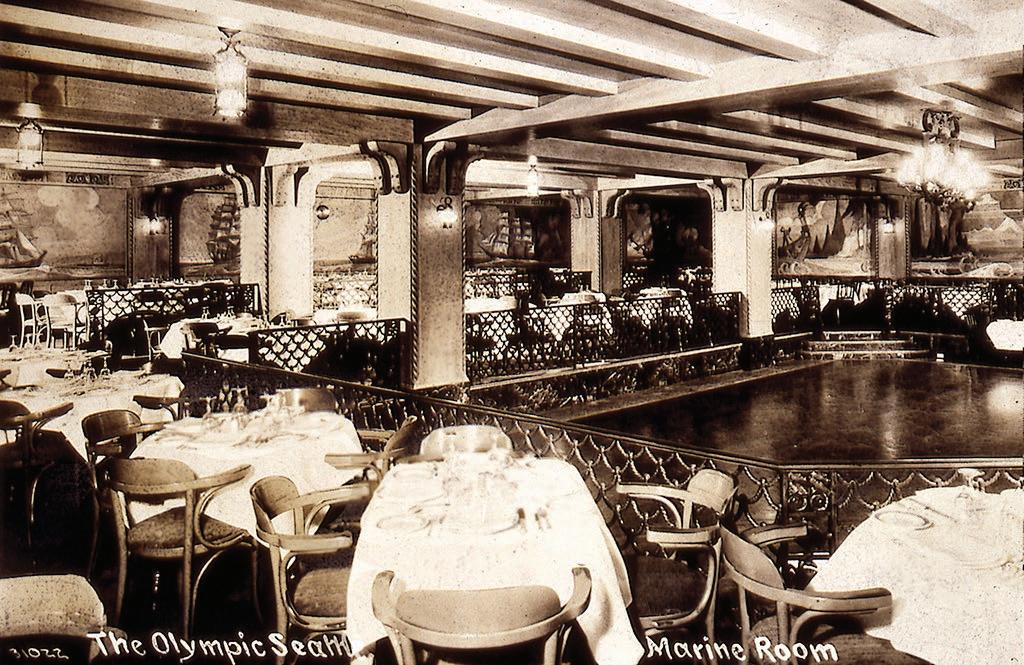
The sounds of the seas beckon him to Seattle. Jacobsen moves to Seattle, WA, and made a living as a carpenter with fellow Norwegians. He provides journeyman carpentry on ships and the finished woodwork for the Olympic Hotel.
1911
1890 1910 1909 1912


1904
Jacob’s house in Mindland.
The house in the center is where he grew up.
His boyhood friend, Cousin John, have their first seafaring experiences at age 14. They caught a fish so large they were unable to bring onto the boat. To stay strong and healthy they drank cod liver oil and loved it.
On the farm in North Dakota. He works on his uncles’ farm in North Dakota. His cousin John stays on the farm in Crosby and becomes very successful.

Promoted from able seaman to skippering ships.
Jacobsen acquires jobs on fishing vessels going to Arctic Alaska and becomes involved in whaling—ultimately becoming the skipper with harrowing whaling stories.

11
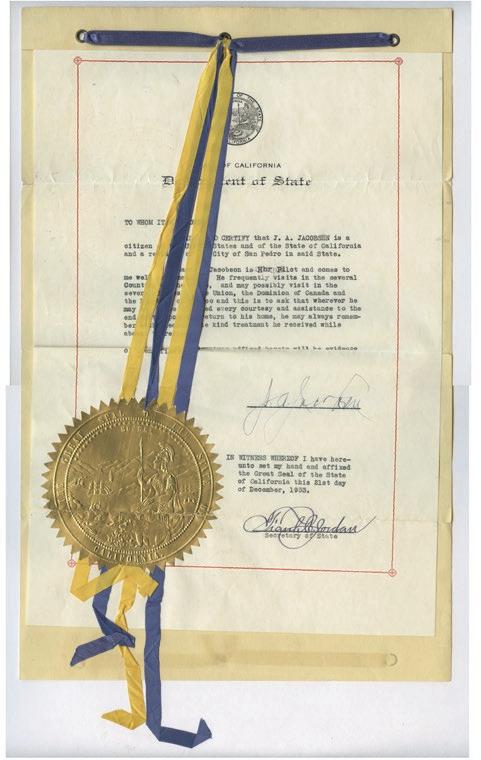
Naturalized citizen of the U.S. Jacobsen becomes a naturalized U.S. District Court, Seattle Washington February 29, 1916.

Commercial Shipping on the Sturzen Berry Line.
After WWI, he returns to international shipping and sails with the Sturzen Berry Line. His first Captain’s job is on the cargo ship SS West Jena in 1919 and later Captains the SS West Prospect.


Founds J.A. Jacobsen & Company which later becomes Jacobsen Pilot Service.
The Port of Long Beach asked Jacob to serve as their Pilot. In 1924, Long Beach isn’t much of a port—mostly “mud flats”.
Marries Elise Gulbransen.
Jacob marries Elise on October 22, 1924. They live San Pedro and raised three children: Jack, Richard and Andrea.
The first flag.
When Jacob is invited to create a Pilot Service in Long Beach Harbor, his wife Elise hand-stitches a flag of her own design to hoist for the community to recognize. (Shown on page 13.)
1916 1923 1919 1924
1918
Enlists the U.S. Naval Reserve in WWI.
Made a Lieutenant, he is assigned to the transport service responsible for both troop and cargo shipped to overseas posts.
Tokyo-Yokohama Earthquake and helping U.S. citizens get medical attention.
On his last tour as Captain of the SS West Prospect, the ship berths in Yokohama, which has been devastated by a magnitude 8.3 earthquake and resulting fires. Jacobsen helps U.S. citizens by providing voyage to medical facilities.
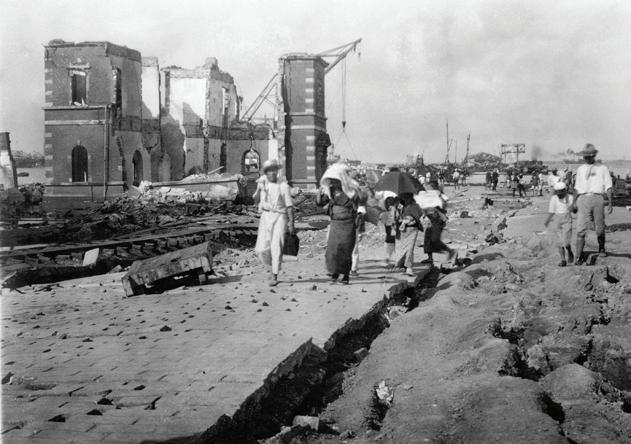
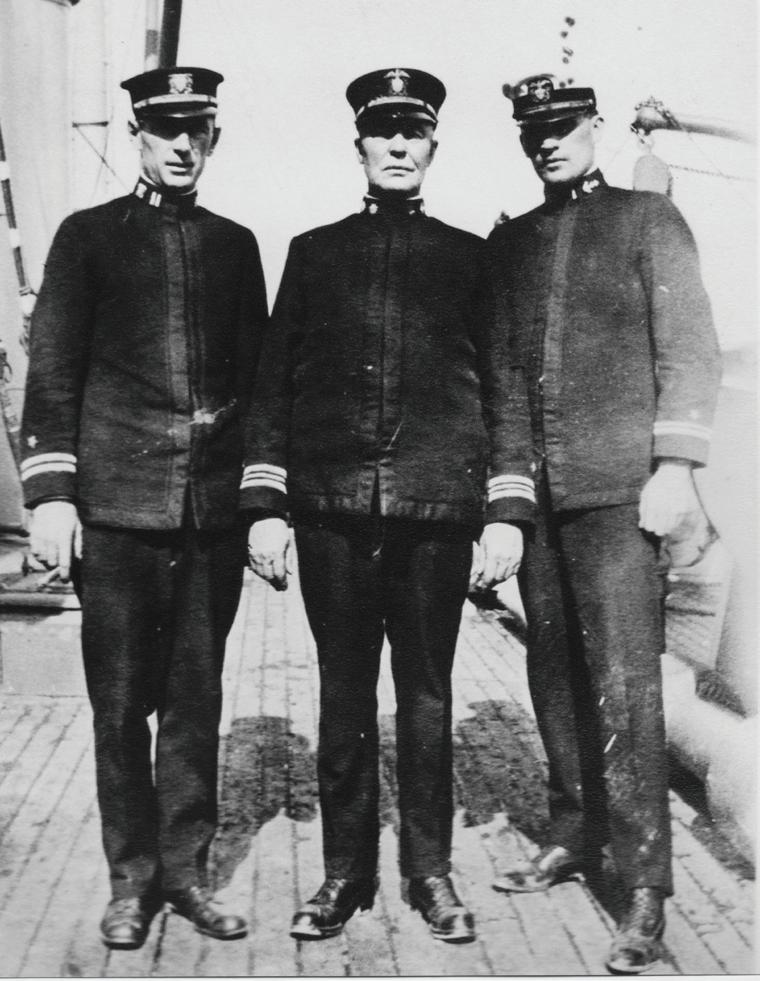
Lieutenant Jacob Jacobsen.
Jacobsen serves as a Lieutenant in WWI. (Standing on the right.)
12

TAKING COMMAND, CHARTING HIS COURSE
Now a ship’s Captain, Jacob Jacobsen proves his mettle in the Pacific Ocean.
In 1922, Jacob was given his first ship’s command in the Merchant Marine, when at age 32 he was hired to skipper the SS West Gena. In 1923, he moved to Captain of the SS West Prospect a cargo vessel on the shipping lines with Japan. On September 1, 1923, he steered the SS West Prospect into the port city of Yokohama to find that, only hours before, much of Japan had been hit by a devastating earthquake. Fires raged in the city, killing tens of thousands. Within hours, he and his crew had come ashore, rescued more than 50 injured, including the U.S. Consulate staff, and sailed to Kobe so they could receive medical attention.
That was to be the last of his many adventures at sea. Returning to the West Coast of the United States, he’d decided on a new course. He’d sailed the world’s oceans for 15 years, but from now on his adventures would take place within the waterways of San Pedro Bay. In late 1923, Captain Jacobsen offered his services as an independent Pilot to Billy Wickersham, a busy ships agent. At the time, Southern California was experiencing an oil boom.
A forest of oil derricks in Long Beach, Signal Hill, and Seal Beach pumped barrel after barrel of oil that needed shipment. His first account was with shipping agency
W.H. Wickersham and Company, handling oil tankers for Standard Oil, Atlantic Richfield (ARCO), and others. Soon after, in early 1924, he officially founded J.A. Jacobsen & Company, the first iteration of what is now Jacobsen Pilot Service.

13
CHAPTER 1
The ship register log book from the Marine Exchange which recorded Captain Jake’s last voyage into the Port of Los Angeles on the SS West Prospect on September 24, 1923.
THE EARLY YEARS
The mud flats of Long Beach and a nation flat broke.
Jacob Jacobsen was an ocean-loving mariner; however, once he settled on Long Beach Harbor, he also turned out to be a natural-born businessman.
When he founded J.A. Jacobsen and Company (the predecessor to Jacobsen Pilot Service) in 1924, he already had three clients: WH Wickersham and Co, The Port of Long Beach, and the U.S. Navy.
The key to his initial success was simple: Jacob Jacobsen was a man of his word and his clients felt fully confident that, when he said he could do something, it would be done to the highest standards. In the days before ISO 9000 certifications, he established a company culture based on safety,

quality, and accountability. He understood that with large amounts of capital at risk with every shipment, what his customers valued above all else was trust.
In 1935, a strike by Longshoremen threatened to bring the Port of Long Beach to a halt. Ships could not be unloaded and began to seek other ports.
When tugboat operators joined the walkout, Jacob fulfilled his commitment to his customers. When a Cunard luxury liner needed to come into port, he confidently Piloted it without the aid of tugboats.
The strike was just one of many challenges faced during the Depression. To keep the company afloat as the Piloting business slowed, Jacob added a
range of services, including harbor water taxis, garbage barges, and a passenger speed boat.
By the time President Franklin Roosevelt ran for an unprecedented third term in 1940, the American economy—and shipping’s role in it—was starting to recover from the long economic slowdown. But nobody—not even Jacob Jacobsen—was prepared for the global catastrophe that was to come next.
With hard work and dedication to serving its customers, JPS successfully navigated from humble beginnings through the Great Depression.
14
CHAPTER 2

Partners with her husband from the very beginning, Elise did whatever the business needed, from book-keeping to answering phones to driving him to jobs—all while running the household and raising a young family.

Jacob

and Stripes.
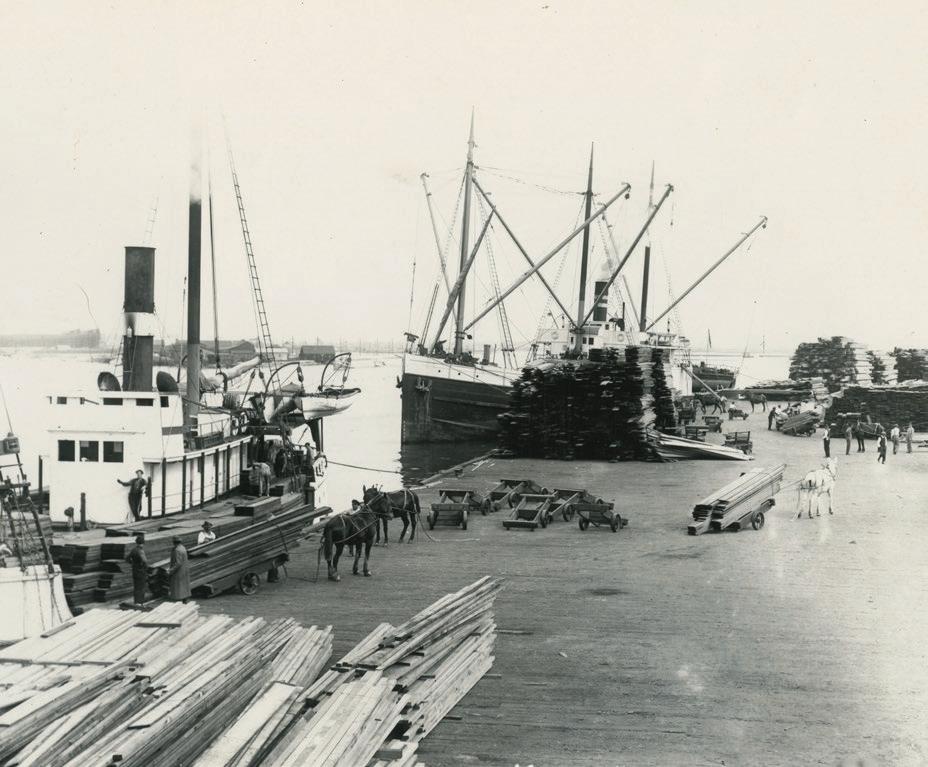
Marine surveying and ship maintenance.
JPS adds Marine Surveying to supplement the Pilot business.
Handled general and special surveys for cargo ships and ship maintenance.
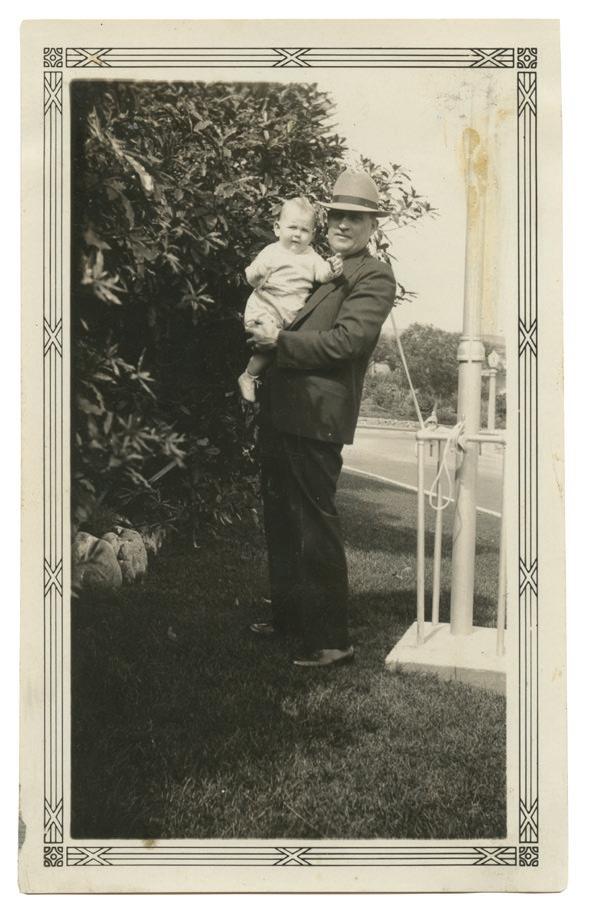
Water taxis, garbage barges, and a passenger speed boat.
The Piloting business is very slow, so Jacob adds services including harbor water taxis, garbage barges, and a passenger speed boat.


15
Elise Jacobsen.
Richard Jacob Jacobsen is born.
New house and home office built.
and Elise build a new house in Averill Park, San Pedro. The house serves as a home office and has a large concrete pad with a tall flag pole so Jacob could proudly hoist the Stars
1931 1929 1937 1935
Elise Andrea Jacobsen is born.
1925 1924

16
The U.S. Navy Pacific Fleet, 1939: Shown anchored at their home base in the Port of Long Beach, inside the breakwater. Captain “Jake” Jacobsen serviced the fleet, which included aircraft carriers, battleships, and other Navy vessels. Berthed inside the Port are steam schooners, three-mast schooners, cargo ships, and oil tankers also Piloted by Captain Jacobsen.

Immediately before the start of World War II, it became apparent that a major anchorage and operation area was needed in the Los Angeles-Long Beach-San Pedro basin.
In 1940, the City of Long Beach ceded 108 acres of land on Terminal Island to the U.S. Navy to establish a Naval Station.
17
Jacobsen Pilot Boat Venus alongside the battleship USS Missouri: The war in the Pacific ended on September 2, 1945, with Japan’s formal surrender on the deck of the “Mighty Mo”. The ship stopped in San Pedro on November 27, 1944, during her journey to the Pacific War and on later occasions for maintenance and modernization.
TO GROW AND GROW ALIKE
From its initial founding, through the middle decades of the 20th century, the story of Jacobsen Pilot Service is inextricably linked to the story of the Port of Long Beach.

18
CHAPTER 3
Jacob Jacobsen’s view of the Port in 1925. A shallow entrance with narrow canals, but a lot of potential.

Billy Wickersham in 1924
As a shipping agent, he was the first customer of J.A. J & Co. and founder of the Marine Exchange.
On June 24, 1911—while Jacob Jacobsen was still in Seattle—Long Beach mayor Charles Wyndham dedicated the new Port of Long Beach.
It showed the vision possessed by the citizens of Long Beach, who’d voted two years earlier to fund the Port.
The Panama Canal would not open until 1914, but when it did, it would transform trade across the globe.
Another key event occurred in 1914: the outbreak of WWI. By the time it ended, Long Beach would be affected by the post-war plans of the U.S. Navy. In 1919, it divided into Atlantic and Pacific Fleets, with Long Beach chosen as the West Coast home port for the Pacific Fleet.
Long Beach made an ideal anchorage for large ships. A 2.11-mile breakwater completed in 1910 helped create near-perfect operational conditions for a commercial port. The Port was near offshore island gunnery drill grounds that had immediate access to the sea. And, with the oil fields of Southern California booming close by, cheap oil was readily available.
However, when Jacob Jacobsen first laid eyes on it in 1923, Long Beach wasn’t much of a port—it was mostly “pungent mud flats, smelling of decaying shellfish.”
His first client was shipping agent W.H. Wickersham & Co., who handled work for all the major American oil companies. Jacobsen’s reputation grew quickly and he added other accounts, among them the U.S. Navy and the fledgling Port of Long Beach. For both the Jacobsen Company and the Port, growth was steady but slow during the late 1920s.
To make matters tougher, in 1929 the Wall Street Crash triggered the Great Depression. The longest and deepest economic downturn in the history of the U.S., its impact on the modern industrial economy lasted throughout the 1930s.
Nonetheless, long-range planning for the Port’s expansion continued. In 1930, an extension of the breakwater was approved. (It would be extended again in 1942 during WWII.) In 1932, Long Beach built a large Navy Landing. By the next year, more than 50 ships and 30,000 sailors were stationed at Long Beach. The first transit shed on Pier A in the outer harbor was completed during this period, too. And the first oil wells within the Harbor District were drilled, providing oil revenues to the City and Port of Long Beach.
All of these developments would impact Jacob Jacobsen and his own expansion plans. As a supplemental revenue source, he offered a water taxi service and a Marine Survey subsidiary. A specialized business within the shipping industry, the Marine Survey company advised ship owners and dock workers how to load the ships more efficiently and balance cargo loads to ensure that ships sailed with speed and stability, while minimizing the loss of cargo due to damage while at sea.

This side business was entrusted to Jacob’s son, Jack Jacobsen. A gregarious fellow known to everyone around the harbor, he hired many longtime employees and developed the Marine Survey company into a business valued as much for the connections it forged and the information it gathered as for the revenue it generated.
These efforts enabled Jacobsen to survive the Great Depression of the 1930s, just as more world-changing events were about to come.
Jack Jacobsen in 1940
19
A graduate of California Maritime Academy, Jack served as a chief engineer in WWII, before moving on to become a surveyor for J.A. Jacobsen & Company.
World War II: September 1, 1939–September 2, 1945

Even before the attack on Pearl Harbor on December 7, 1941, it became apparent that the United States would face threats in the Pacific and that a major anchorage and operation area was needed in the Los Angeles-Long Beach-San Pedro area. In 1940, the City of Long Beach ceded 108 acres of land on Terminal Island to the U.S. Navy for $1. The Naval Shipyard was now stationed within the Port of Long Beach. Considered the most modern facility in the nation, the complex employed more than 16,000 people at its wartime peak.
The war-fueled growth in vessel traffic within the Port created a challenge to safe operation. Thankfully, there was someone equal to that challenge, right in Long Beach. In 1943, the U.S. Navy hired J.A. Jacobsen to run the Navy Pilot Service in Long Beach. More than 25 Pilots were hired and trained to handle the dramatic expansion of ship traffic during the last three years of WWII. Rather than slowing down when the war ended, business in the Port of Long Beach—and thus for JPS —remained strong in the late 1940s, as military vessels gave way to the return of commercial vessels. In 1947, Long Beach Port Manager Eloi Amar proposed that a modern Pilot Station be built on the tip of Pier A, with Jacobsen contracted to provide Pilotage. Jacobsen moved its base of operation to the first Pilot Station constructed in the Port of Long Beach at the end of the original breakwater. Jacobsen brought with him five ship Pilots, one Boat Operator and one Dispatcher.
He also brought with him a bold idea for 1949: the use of new radar technologies to help mitigate the risks of navigating at night and in fog. Its installation in Long
Beach Harbor would mark its first use anywhere in the Western Hemisphere. Along with his simultaneous introduction of a new Port traffic plan, it would solidify Jacob Jacobsen’s position as an innovator in the maritime industry. 1949 marked the 25th anniversary of Jacobsen Pilot Service. It had been an exciting quarter-century, driven by the ambition and vision of Jacob Jacobsen.
As he entered his 60s, there was no sign of Jacob slowing down. In fact, there was a sign he might eventually be joined by his son Richard, then a high-schooler who was beginning to think about which college to attend. In 1949, he entered the California Maritime Academy, a college that instills in its Corps of Cadets a highly disciplined understanding of maritime subjects as they apply to both military and commercial operations. After graduating Cal Maritime in 1952, Richard became an officer in the U.S. Navy and served his country before joining JPS.
Richard would join JPS at a pivotal time. A major change was just emerging within the shipping industry: the cargo container. In 1962 Sea-Land Services, a U.S.-flagged shipping company, began its operations at their Pier G container terminal in Long Beach. The carrier was the first to offer an innovative cargo handling system called containerization. For JPS and the Port of Long Beach, it was the beginning of the “containerized cargo revolution.” Containers proved much easier than moving bulky packages, drastically increasing the amount of goods moved throughout the ports. And the container ships would begin a trajectory of ever-increasing size that continues to today.

20

21
1944: A pontoon bridge connects Long Beach to Terminal Island and the Naval Station. Intended to be temporary, it remained in place until replaced by the Gerald Desmond Bridge in 1968.

New Pilot Boats: Polaris 1 and Vega.
Just prior to the coming WWII expansion of Port traffic, JPS takes delivery of the 40-foot Polaris I and the 34-foot Vega. These new Pilot Boats will play a small but critical role in the war effort, facilitating the safe movement of countless vessels carrying troops and supplies to the Pacific Theater and beyond. They would go on to serve JPS for decades.
First hire: Ramona Merle.
Ramona is hired to provide bookkeeping and help out at the San Pedro office.

Attack on Pearl Harbor.
Early on December 7, 1941, citizens and service members alike in Pearl Harbor, Hawaii, face terror, as Japanese planes rain fire on the island in a stunning surprise attack. The assault quickly plunges the United States into a world-changing war.


JAJ joined United States Coast Guard. As WWII unfolds, 53-year-old Jacob joins the Coast Guard. Commissioned as a Lieutenant Commander, his duties include the piloting of military ships within the Port of Long Beach.

Radar leads the way.
Working with Port engineer Tom Thorley, Jacob installs the first shore-based ship-assist radar used in commercial ship navigation in the Western Hemisphere. Radar was used to direct Pilots aboard ships in times of limited visibility. The device and technology are submitted to the USCG as a national port practice and was featured in Popular Science magazine.
Post-war expansion: first station, key hires.
Long Beach gets its first dedicated Pilot Station. Key hires include Hans Christensen, Sigourd Ouglund, Carl Aultman, Frederick Meyer and Elmer Engel as Pilots; Edward Gorman as Boatman; and James Gargan as Dispatcher.

Motorola VHF radios.
JPS and Motorola work in tandem to introduce the use of portable two-way VHF radios to help Pilots communicate their instructions between tug boats, boat operators and the Pilot Station.


Richard Jacobsen graduates from The California Maritime Academy.
This rigorous formal education in a broad range of maritime subjects lays the foundation for Richard Jacobsen to eventually succeed his father.
22
1941 1940 1947 1943 1949 1952

SHORE-BASED RADAR TECHNOLOGY IS FIRST IN WESTERN HEMISPHERE
Captain Jacob Jacobsen applies radar to make Piloting safer.
Bringing a large ship to berth under low-visibility conditions like fog is the biggest challenge for Pilots. The establishment by JPS in 1949 of the first shoreside radar unit and traffic guidance plan dramatically improved maritime safety within the Port of Long Beach—and as far out as 20 miles. In even the foggiest of conditions, JPS Dispatchers, Pilots and Boatmen could now “see,” with a real-time radar view of ship navigation and port traffic. The nerve center of the operation was the radar unit at the Pilot Station. It worked similarly to the ground control approach radar system at an airport that guides airplane pilots on an airport runway.
The “miracle system” was developed and implemented by Captain Jacobsen in conjunction with Port Manager E.J. Amar, Harbor Commissioner W.R. “Frosty” Martin, and Tom Thorley. Maneuver instructions were communicated to the Boatman via two-way radio while the vessel’s course was constantly followed on a radar scope. More importantly the shoreside Pilot monitors the bank of navigation instruments on the console and uses the radar screen to assist the inbound Pilot to bring the ship safely through conditions of low visibility to berth in the Harbor—thus saving the ship owner in shipboard costs and longshoremen delays.
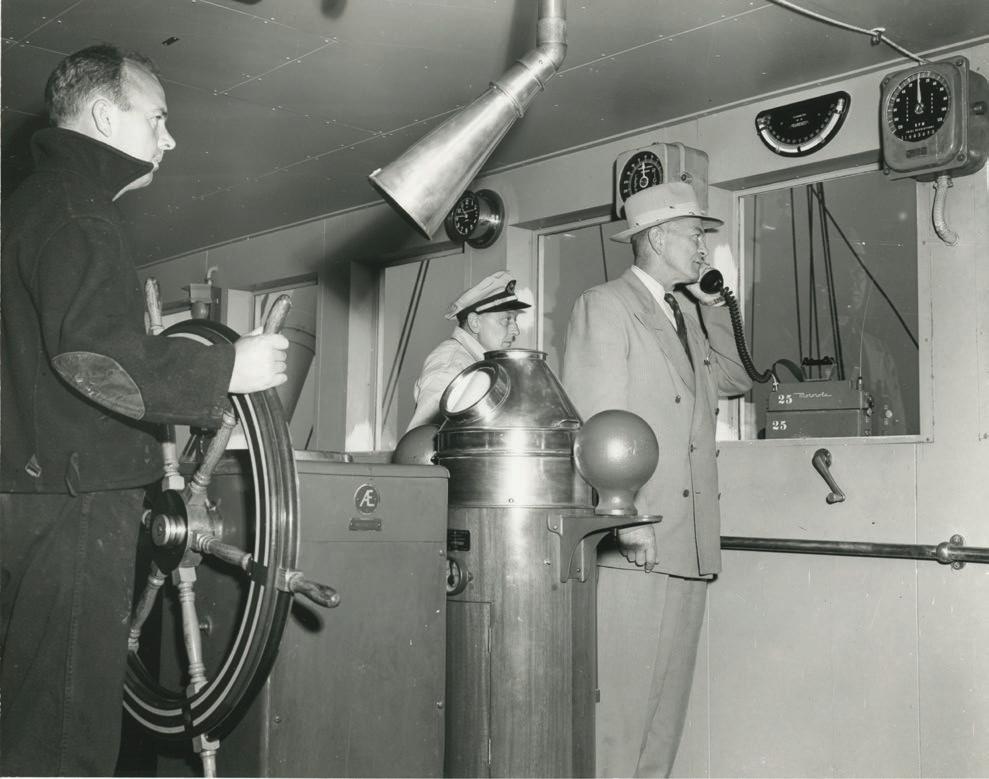
23
Stationed on the bridge, Captain Ougland calls the Pilot Station for course directions to follow through the fog. The heading is repeated by the Pilot to the Ship’s Officer, who in turn transmits the order to the Helmsman.
CHAPTER 3

Fog is the seafarer’s ancient enemy. In our modern maritime world, JPS Pilots are aided by advanced radar systems that ensure the safe navigation of large oil tankers and container ships as they move within the fog-shrouded Port.
24

25

Jacob Jacobsen operated on instinct, common sense, and old-world values.
For his son Richard, the challenge when he took over in 1960, was to build on that legacy–by adding the fiscal, technical, and operational sophistication to guide the family business into the modern world.
He succeeded, thanks to his vision, innovations in safety and technology, and gift for team building.
26
RICHARD JACOBSEN CEO: 1960-1998
The Legacy Continues
At his inauguration in January of 1961, President Kennedy famously said, “Let the torch be passed to a new generation of Americans.” Richard “Dick” Jacobsen was among that new generation. Only a few months earlier, he’d become President of Jacobsen Pilot Service at age 29. He began to reshape the firm, while at the same time the Port of Long Beach was equally ambitious, preparing both for unprecedented growth in the coming decades.
Trans-Pacific trade had grown slowly in the 1950s. However, by the early 1960s, Asian economies began to rapidly modernize. Japan started to ship the first Toyota, Datsun and Honda automobiles imported to California. By the 1970s and 80s, Taiwan and South Korea would send cargo ships loaded with clothing, toys and electronics bound for American retailers. And in the 1990s, the expansion of China would totally transform global shipping. One key factor would spur this massive growth: the introduction of the container ship. Its impact on Long Beach and JPS would be profound.
But Dick Jacobsen was well prepared for what was to come. He was educated at the California Maritime Academy, where he learned the most valuable lesson of all: how to build and lead teams of people. In the U.S. Navy, he rose to the rank of Lieutenant. After the Navy, he served in the U.S. Merchant Marine before joining JPS as a Pilot in the late 1950s.
During these early years, Richard realized something important: Long Beach had competition—and not just from the Port of Los Angeles. The Ports of Oakland, Seattle and Tacoma also sensed the growth potential from Asia’s surging economies and would vie with Long Beach for trans-Pacific shipping.
To prepare for all this, Richard made a bold move: in 1964, now as CEO, he ushered in the company’s incorporation and made JPS Pilots shareholders. There was now a vested interest for JPS Pilots to perform at the highest levels of safety, efficiency, and service. And, after a new Pilot Station was built in 1968,
he made sure to support it with the most advanced technologies and rigorous training programs. In doing so, he laid the foundation for a culture of teamwork that continues to this day.

If you visited the office of Richard Jacobsen, you were not likely to find him in his chair. He was not a sitter. He preferred to be on his feet, on the phone, or out in the Port, building relationships with the wide network of shippers, port customers, harbor commissioners, and others who he made part of an extended team. Working all day, every day—even Christmas Day—this visionary leader helped ensure that the Port of Long Beach evolved into one of the most innovative, technically advanced, and safest ports in the world.
CHAPTER 4 27
LOOKING FORWARD
A visionary leader, Richard set the course that allowed JPS to navigate four decades of dramatic changes.
Richard Jacobsen was driven to build JPS into a world-class Piloting service, with safety as a cornerstone along with efficiency and customer service. To do this, he began keeping records on accidents that were costing the company money. Once he was able to track costs, he identified actions to reduce accidents and damage to cargo, and trained his team to uphold those standards. By improving safety, JPS would also be able to negotiate better contracts with marine insurers—a critical aspect of the shipping industry.
When Richard restructured the company to allow Pilots to own stock in the business, everyone shared in the outcome: A safer operation was a more profitable operation.
With his attitude that “We are all in this together,” Richard set the tone. He offered enhanced employee benefits and designed work schedules to reduce on-the-job fatigue and make family life more manageable. Always interested in applying new management ideas, he made sure JPS was a case study in teamwork, professionalism, and modern business methods.
Serving on many civic and maritime-related organizations, Richard spearheaded the collaboration with the Marine Exchange and Port of Long Beach to implement the latest technologies. As radar evolved, Richard saw to it that the Pilot Station upgraded to the most advanced radar as soon it was available. In the late 1990s, he urged the early adoption of cutting-edge radar technology with fiber optics and microwave for remote radars.

28
CHAPTER 4
1961: Installing new radar equipment at the Pilot Station. The tower is a repurposed oil derrick .

29
1961: Young CEO Dick Jacobsen with Pilot Boats Vega and Polaris. In the distance are U.S. Navy ships. Over the next 40 years, he would lead JPS as the Port undertook a total transformation.
CONTAINERIZATION
The shipping container revolutionizes the global economy.

The world’s first container ship sailed from Newark to Houston in 1956. It carried 58 shipping containers. In 1968, the International Standards Organization (ISO) set the dimensions of a shipping container: 20 feet long, 8 feet high and 8 feet wide. Since then, successively larger vessels have been designed to carry an ever-greater number of containers, measured in 20-foot equivalent units, or TEU. By 2024, the world’s largest container ships carry 24,346 TEUs.
There are currently 20 million shipping containers traveling between ports the world over. As the
Economist asserted, “the shipping container has been more of a driver of globalization than all the trade agreements in the past 50 years together.”
With each new generation of container ships, shipping goods made in far off countries becomes more cost-effective. This economic scale has revolutionized not just ships, but also ports, rail networks, roadways, and cities all over the world.
While even he could not have imagined the size of today’s largest container ships, Richard Jacobsen did envision how Long Beach must respond to this new era of containerization through the coordinated effort of a wide range of entities, including the Ports of Long Beach and Los Angeles, and other local, state, and federal transportation agencies.
So, in his quiet, take-no-credit way, he worked his network of relationships, establishing a shared vision of how Long Beach and JPS would need to stay competitive as the era of containerization began
to unfold. In 1972, Pier J was expanded to become a terminal for Toyota. That same year, ITS completed a container terminal on Pier J with a 11,200-foot wharf.
Towards the end of Richard’s career came one of the most significant developments. In 1997, the closure of the Long Beach Naval Shipyard created a massive opportunity to expand the Port’s facilities. By the time Richard retired in 1998, Long Beach was one of the world’s largest container ports—and JPS Pilots were busier than ever.

30
CHAPTER 4
2019: MSC Eloane with a 19,500-TEU capacity.
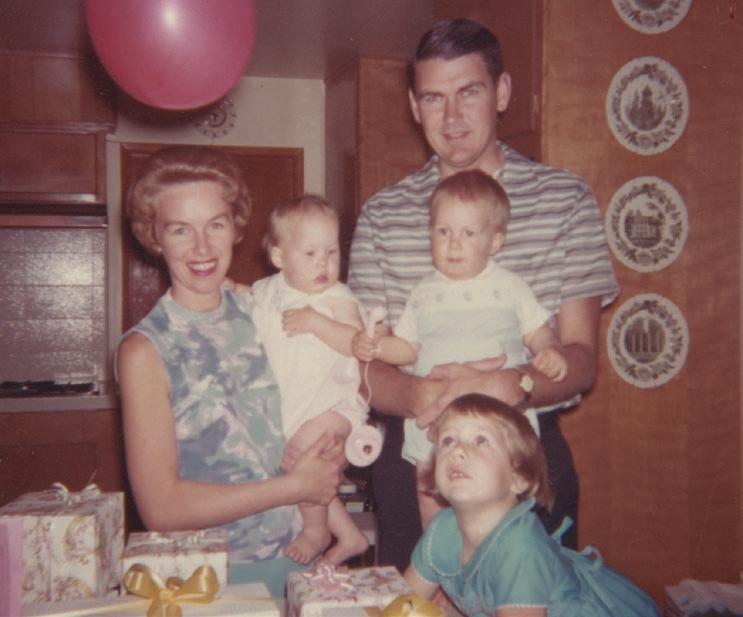
Twins—Thomas and Linda—are born in 1964 and join their older sister, Katherine, to complete the family.
Taking over as President of JPS in 1960, Richard seamlessly moves between his two worlds of work and family. Family photos, not business commendations, dotted his office walls. In turn, Jacobsen teaches his children to appreciate the family business.
1964

The Queen Mary arrives at the Port on December 10.
The ship arrives after a voyage from England around the tip of South America. JPS was entrusted to Pilot this famous vessel, led by Number One Pilot, Captain Carl Aultman, and his Number Two Pilot, Richard “Dick” Jacobsen. In 1971, after four years of work at the Naval Shipyard, the Queen Mary was moved by JPS Pilot, Captain Jim Common, to Pier H and opened as a hotel, museum, and tourist attraction.
1967
The company is restructured to include Pilots as stockholders. Port Pilots are now part of the family and are responsible for safety, profitability, and customer service.


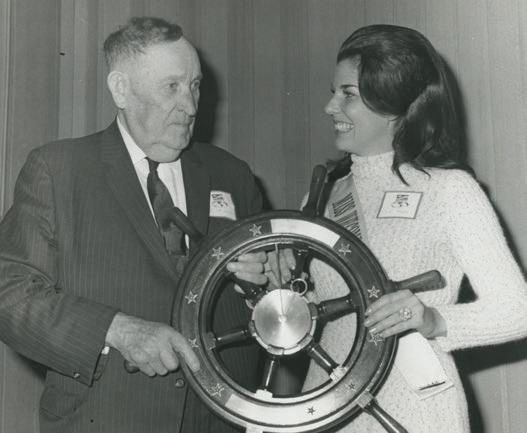
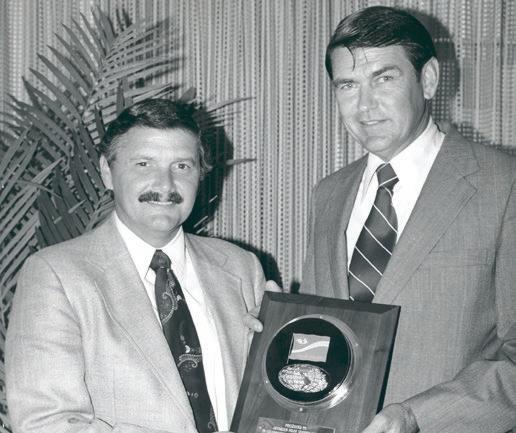
J.A. Jacobsen receives the Honorary Port Pilot Award.
The Port of Long Beach presents the award to Captain Jacob Jacobsen. Presidents Roosevelt and Reagan were previous recipients.
Dick Jacobsen receives the same award in 2002.
The presentation to Dick Jacobsen in 2002 marks the first time that the Honorary Port Pilot Award has been awarded to a father and son.
1971
1968
The Gerald Desmond Bridge opens.
Connecting Long Beach and Terminal Island, the $13 million span replaces the pontoon bridge and clears 155 feet high. In 2004, the MSC Texas was Piloted under the bridge and into the harbor with only 3 feet of clearance.


New Pilot Station built its new location at Pier F.
The station is moved from its 1947 location to the tip of Pier F. In later years, it will be upgraded with radar tower and other technologies.
31
JACOBSEN PILOT STATIONS 1936-2024



1968: With vessel traffic growing dramatically, the Port’s expansion plans include a new Pilot Station, in a new location at Pier F. It would be remodeled in 1980 and again in 1997.

32
1936: The J.A. Jacobsen and Company office opens at the Cabrillo Fox Theatre in San Pedro, next door to the W.H. Wickersham & Co. and near the Jacobsen’s home.
1947: The first modern Pilot Station is built. Long Beach Port Manager Eloi Amar proposes that it be built on the tip of Pier A.
TRIBUTE TO CAPT. JACOBSEN 1890-1980




Under Jacob Jacobsen’s guidance, the Jacobsen Piloting Service met the challenge and established a reputation respected throughout the maritime industry. As he worked, he was always looking for better ways for the Pilot Service to serve the growing port. No one could have had more loyalty toward—or been as proud to be part of—the “mudflat port” that had become the leading harbor in this nation.



33
Left to Right: Captain Jacob Jacobsen, his son Richard, and Ben Knutsen.
Jacob A. Jacobsen passes away.
TRAFFIC CONTROL
Richard collaborates with the Marine Exchange, USCG, and Ports of LA & LB to create Vessel Traffic Systems.

In 1949, Jacob Jacobsen installed the first shore-based radar in the Western Hemisphere. It was an innovation that improved the safety of vessel movements. At the same time, Jacobsen Pilot Service became responsible for vessel traffic control within the Port of Long Beach.
Over subsequent decades, as the Port grew into one of the largest container ports in the U.S., the traffic safety system continued to integrate new technologies. By 1981, the growth in ship traffic led the Marine Exchange to create the Vessel Traffic Advisory Service (VTAS). The predecessor to today’s Vessel Traffic Service (VTS), it monitored vessels approaching and departing Los Angeles and Long Beach harbors. Initially voluntary and informal, the large number of vessels that used this program led to considerable enhancements in navigation and safety.
In 1989, the tanker Exxon Valdez ran aground in Prince William Sound, AK. The incident triggered a slew of new safety regulations from the Federal Government and State of California. VTAS transformed into the formal and mandatory VTS, operated jointly
by the U.S.C.G. and the Marine Exchange in a unique public/private partnership that includes JPS as the LB Sector of the VTS. In 1990, a fiber optic-connected radar was added on Pier J and was soon followed by microwave-connected radar in the inner harbor. As Tom Jacobsen said at the time, “These developments gave JPS’s Pilot Station complete coverage of the whole harbor.” Beginning in 1991, VTS took on added capability of guiding ships in the approaches outside the harbor, with the Pilot groups in LA and Long Beach each handling their own traffic within the breakwaters of their respective ports. It was something Jacob Jacobsen had likely envisioned years earlier, but that hadn’t been technically feasible before.
 Dispatcher Troy Waters.
Dispatcher Troy Waters.
34
Captains Vic Schisler and Grant Livingstone.
CHAPTER 4

The Port of Long Beach wins the American Association of Port Authorities Environmental “E” Award.
Long Beach wins the honor for its comprehensive program and broad scope of achievement in environmental matters, including oil spill prevention and control.

Container terminal for COSCO.
China Ocean Shipping Co. (COSCO) inaugurates international shipping with the Pacific Container Terminal in Long Beach as its first U.S. port.
1973 1983
New Pilot Boat Commissioned: the Venus.
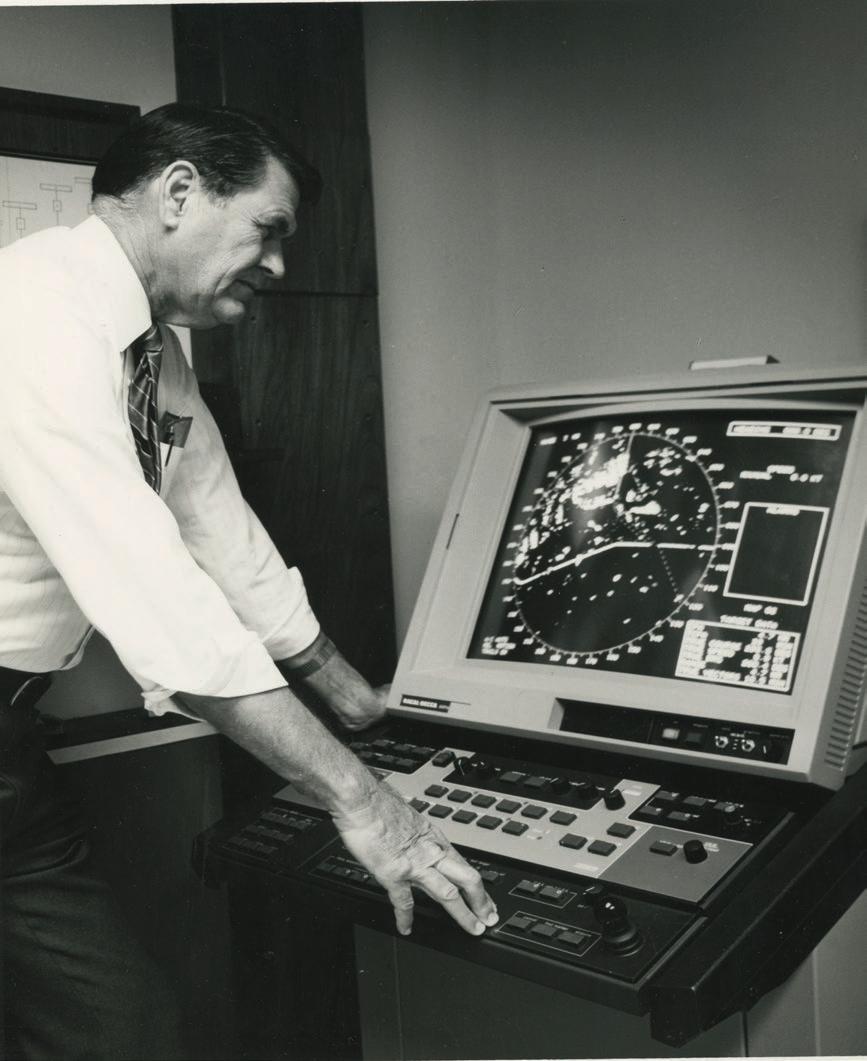
VTS uses radar monitors and computers to synthesize information. On one radar, all of the anchorage spots are pre-positioned so the Pilot can be guided, yard by yard, to the precise point as monitored on the shore-based equipment.
1981 1990
With Port traffic growing, JPS needs new and more sophisticated Pilot Boats. The Venus is built in Costa Mesa. Awards.

1983 Richard Jacobsen receives the Propeller Club award from Rear Admiral Frederick Schubert.


1987 And the Propeller Club’s “Maritimer of the Year” goes to Richard Jacobsen.
Tom Jacobsen at the wheel. Passing the torch: Dick Jacobsen with his son Tom working at JPS.

35
Vessel Traffic Service ( VTS ) launches.

36

Containerization revolutionized shipping and Long Beach became one of the busiest container ports in the world.
37

For the first 75 years of its existence, Jacobsen Pilot Service rose time after time to meet the challenges of a growing Port. But driven by technology and global commerce, the pace of change over the last 25 years has been even more dramatic. Under Thomas Jacobsen, the company’s leadership has had the vision to anticipate the future and the determination to stay a step ahead.
38
TOM JACOBSEN CEO: 199 8-PRESENT
Under Tom Jacobsen, industry-leading innovation would ensure the company’s success in the 21st Century.
Business school journals are filled with articles about the difficulties faced by family businesses as they pass the baton to a third generation of leadership. For Jacobsen Pilot Service, however, that transition was remarkably smooth. After 38 years at the helm, Richard Jacobsen had grown JPS into a modern enterprise. And along with it, his son Tom grew into a highly respected maritime executive, ready to take on the challenges of a new Millennium.
Before going to the California Maritime Academy, Tom grew up around the Pilot Station, being mentored by the professional Pilots who worked there. He spent his weekends and summers working on the Pilot Boats and doing general maintenance. At age 19, he obtained his first U.S. Coast Guard license.
At Cal Maritime in the mid-1980s, he earned a degree in Nautical Industrial Technology and his United
States Coast Guard license as a Third Mate. After the Academy, he spent five years as a mariner, securing his Unlimited Master Mariner’s License while working and gaining experience on a succession of oceangoing freighters, tankers, and bulk carriers in Asia, the Persian Gulf, and the Mediterranean.
Then, in the early 1990s, the JPS Pilot training program had an opening. For Tom, the timing felt right to return home. He entered the multi-year training period, earning the respect of senior JPS Pilots. Soon after, he came ashore and served under his father in management at the Pilot Station. Almost immediately, Tom was instrumental in influencing technological innovation within the company, along with the training on how to use it.
succeed him. Though only 35 years old at the time, Tom Jacobsen’s technical training, maritime experience, and institutional knowledge would lead JPS into the 21st century.

In 1998, when Richard Jacobsen officially stepped down as CEO, there was little question who would
CHAPTER 5 39
Tom Jacobsen monitors the VTS NorControl (top screen) and the SEAiq (bottom screen).
THE ONLY CONSTANT IS CHANGE
While maintaining old-school Piloting principles, Tom also ensured JPS embraced technological innovation.

In 1996, JPS Pilots started taking aboard ships the first computer-based PPU, or Portable Pilot Unit. Called PilotMate, it was co-developed by Jacobsen Pilot Service, the Port of Long Beach, aerospace consultant George Gillow, and together with Annapolis-based ARINC, a navigation technology company. Introducing this navigation aid raised a concern: Would the veteran JPS Pilots adopt such a fundamental change? After all, they’d operated without it their entire careers. But JPS management had long fostered a culture of innovation; so, led by Captains Vic Schisler and John Strong, the veteran JPS Pilots adapted to the new technology. At the same time, newly hired Pilots, raised to rely on
technology, needed to embrace the timeless skills of old-school professional Piloting that no computer could replace.
In 2000, JPS became the first Pilot service in the country to be ISO 9001 certified. It came at a critical moment. With its focus on planning, procedures, and accountability, ISO-certification prepared JPS for the stresses coming from a combination of forces. The era of the megaship, while still a few years away, was clearly coming. So were more stringent environmental regulations and increasing demands from insurers. The PPU was critical in helping JPS manage these challenges. A tablet computer slightly larger than an iPad, it displayed a high-definition chart of the Port, with all of the water depths, and the position of the ship being piloted. JPS Pilots could now see the precise position of their ship’s bow and stern in relation to the shoreline, channels, and other vessels, either moving or docked. Along with ship headings accurate to one degree, it displayed projections of the ship’s location in the next minute, two minutes, and three minutes, which was far more informative than
the older portable GPS equipment it replaced,
PilotMate was a game-changer. By the mid-2010s, with megaships stacking their containers higher and higher, JPS Pilots could no longer see the water in front of the ship or on either side and PPUs became absolutely essential. As new PPUs were developed, JPS management has always made sure that what its Pilots use is the state of the art in terms of accuracy and reliability. Today, the ADNAV XR2 PPUs used by JPS Pilots are powered by SEAiq, the world’s leading Pilot navigation software.

CHAPTER 5
40
Dispatcher James Gargan on duty, 1956.
Dispatcher Rob Tinsley at the Pilot Station 2023.
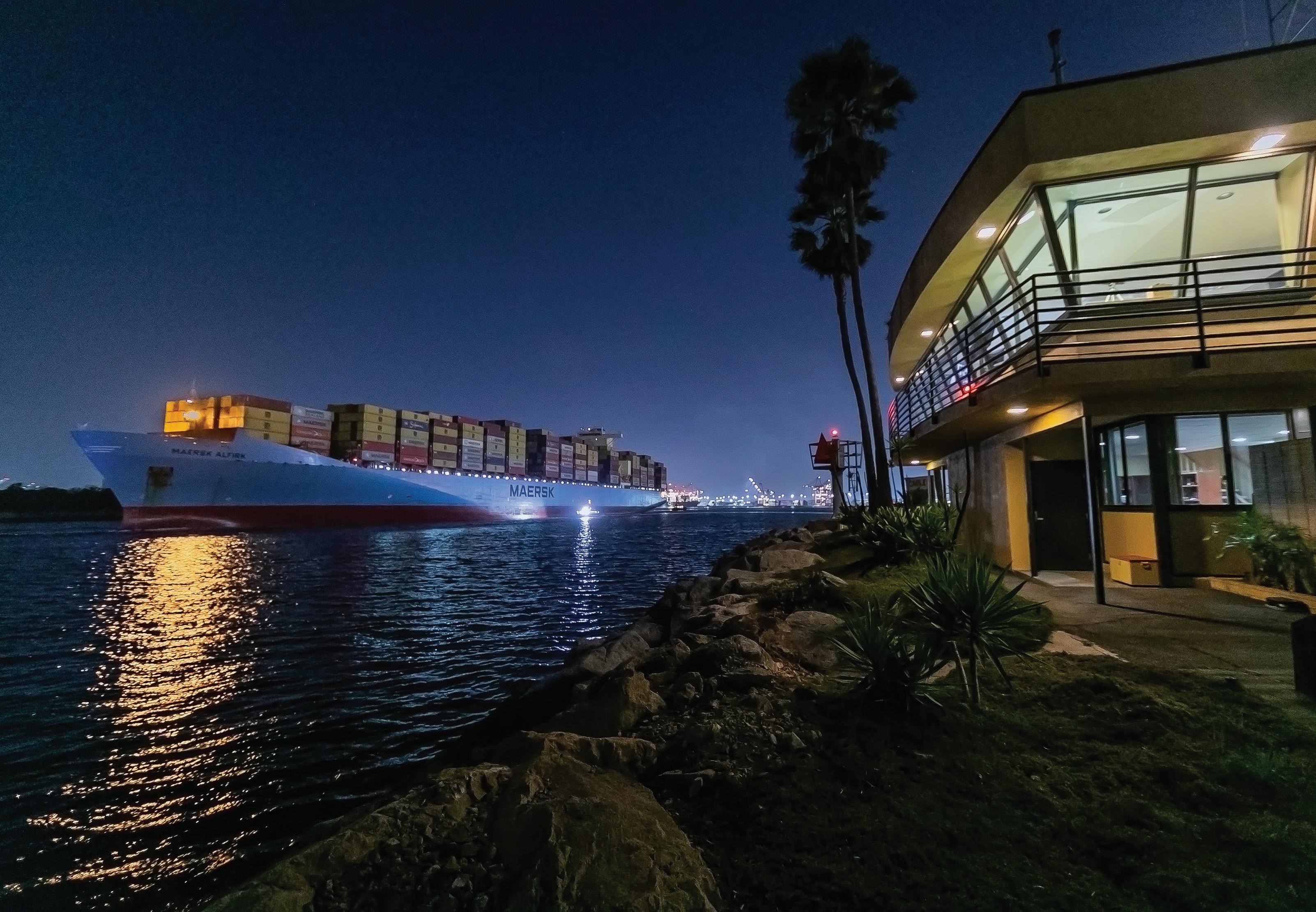
41
THE ERA OF THE MEGASHIP
When a next-level moment in the history of shipping arrived, JPS was ready.
In March of 2012, the future sailed into Long Beach Harbor. It was the cargo ship MSC Fabiola—among the largest ships ever to dock in the Americas.
Its arrival had been anticipated. JPS management was quick to grasp the implications. Collaborating with the California Maritime Academy. JPS Pilots were sent to practice on their advanced Piloting simulator. In simulation run after run, the Pilots refined the maneuvers that would bring the megaship to dock with the assistance of three tugboats, swing her around in the Port’s turning channel, and ease her past shoals on either side.
It was clear from the simulations that the weight and cargo height of these megaships would be uniquely affected by winds and currents. Jacobsen realized that, as ships of this size—and larger—became the norm, a new level of technology and training would be needed to ensure that vessel traffic safety was never compromised. Even after the successful simulations, the reality of docking the Fabiola within the relatively narrow confines of the POLB posed a challenge. Looking back from the point of view of 2024, the Fabiola, at 1,247 feet and carrying 12,500 containers, is not especially large.

The latest Ultra-Large Container Ships (ULCS) launched in the early 2020s carry nearly twice that number. Nonetheless, on that day in 2012, as JPS Pilots guided Fabiola directly past the Pilot Station windows, everyone on duty looked on knowing that the Era of the Megaship would mean major changes for the Port’s infrastructure and for JPS procedures.
Often too tall to sail under the Gerald Desmond Bridge, the megaships would lead to the eventual replacement of the Gerald Desmond by the end of the decade. Opened in 2020, the new International Gateway Bridge is 50 feet taller, allowing today’s larger cargo vessels to pass under it. And, like his father, Tom Jacobsen worked the wideranging relationships he’d fostered to ensure that JPS continues to operate within the most modern, most efficient, and safest port on the West Coast.

CHAPTER 5
42
Captain Joe Fry
MEMORABLE VESSELS PILOTED BY JPS

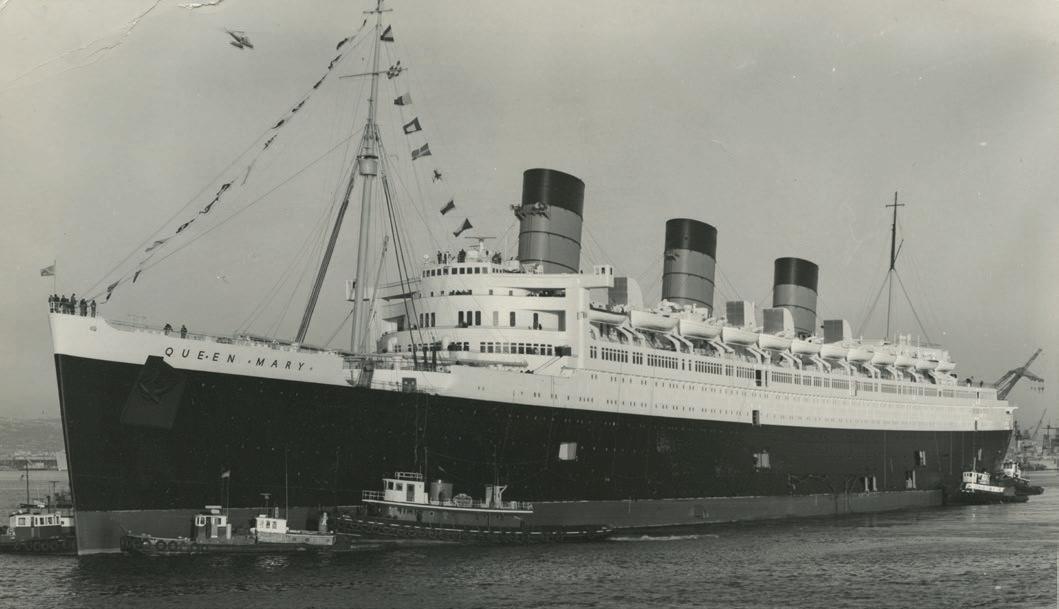

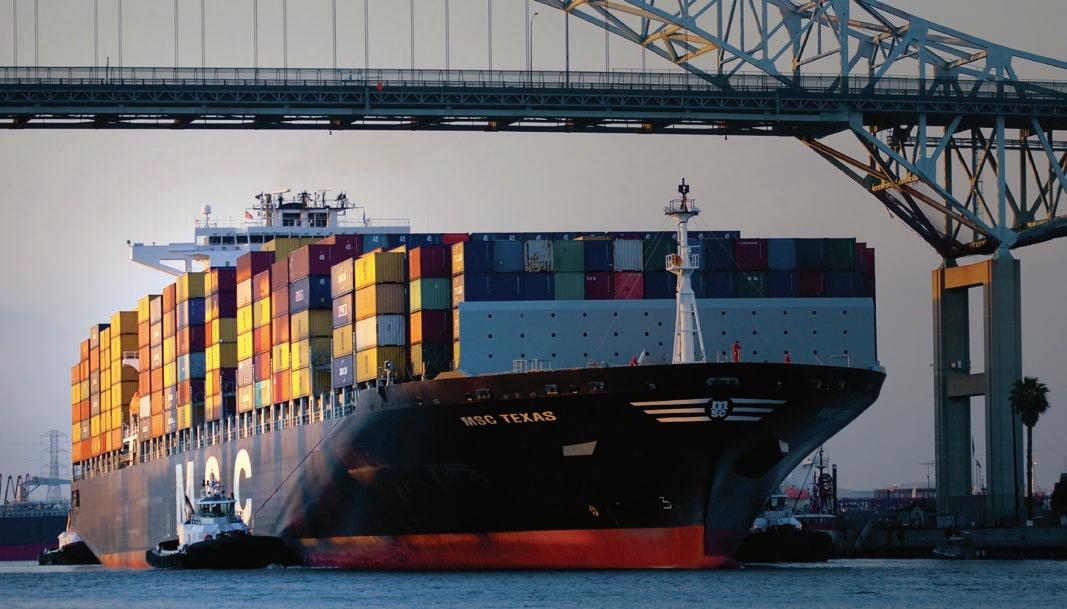





43
Queen Mary, 1967
MSC Texas, 2004
Sea Launch, 2012
MSC Eloane, 2019
Spruce Goose, 1947
Crane ship Zhen Hua, 2007
CMA CGM Benjamin Franklin, 2016
Battleship USS New Jersey, 1986
Queen Mary II, 2006. Welcomed by the Queen Mary
TRIBUTE TO RICHARD JACOBSEN 1931-2014
When he passed away in 2014 at age 83, Dick Jacobsen was remembered as a family man who worked selflessly to modernize JPS—and, along with it, the maritime industry.
Richard influenced many people around the world with his passion for family and for the family business. Guiding thousands of towering vessels into the Port of Long Beach was his job, but his legacy was inspiring the people around him to be persistent and to turn problems into solutions. Known for his work ethic, he made everyone feel like part of the JPS family.
He was a true innovator who loved making improvements to the business and the service it provided. Under his leadership, JPS pioneered the use of new safety-enhancing technologies, that subsequently became standard in the industry. He influenced many lives through his wisdom and compassion, and loved being around the business and the people he worked with.
Dick was a loving husband and father who cherished family times together. He raised his family to enjoy the maritime tradition, farming avocados and citrus, riding and showing horses, and enjoying time together at Mammoth Lakes, where he liked to hike and fish.







CHAPTER 5 44

JPS develops Piloting software and a Pilot navigation system.
In anticipation of larger container ships coming to the Port, JPS introduces a modern, lightweight Portable Pilot Unit (PPU) named PilotMate for use during Pilotage. Another major advance for Pilotage operations worldwide, the PPU provides information to the Pilot that improves safety and efficiency.
1997

World Trade Hall of Fame honors Tom Jacobsen. With his father Richard Jacobsen—already a member of the World Trade Hall of Fame—proudly looking on, Tom Jacobsen humbly accepts his induction into the Hall.
2000
1999
Carnival Cruises comes to the Port of Long Beach. Cruise ship operator, Carnival, announces plans to build a new terminal in Long Beach next to the Queen Mary. When it opens in 2003, the 30,000-square-foot terminal for its two ships, the Elation and the Holiday, takes up nearly half the geodesic dome that once housed Howard Hughes’ Spruce Goose

2006
New Pilot Boat —The Altair.
A new Pilot Boat designed and funded by Jacobsen, the Altair emits zero diesel particulate matter and 84% less emissions than a conventional motor, earning JPS the Port’s Clean Air Award for Innovative Air Quality Improvement Technologies.


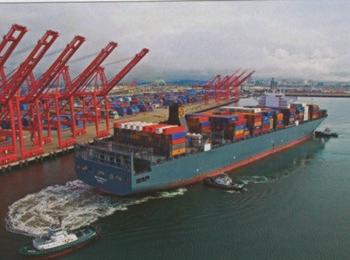

Simulator Training at CMA for MSC Fabiola arrival.
The 12,500-TEU MSC Fabiola became the largest ship ever to dock in North America—its arrival at the Port of Long Beach came off without a hitch. Jacobsen Pilot Service, which was charged with the task of shepherding her in, had planned and prepared for the ship long before its actual arrival. Part of the planning process involves running computer simulations and training at the California Maritime Academy in Vallejo, California.
2012
Jacobsen family.
Richard “Dick” Jacobsen sits next to his wife, Sandra, while standing behind are their three grown children, Tom and his wife Michele, Katherine next to her husband Borgan Anderson, and Linda with her husband Chad Fester. Seated are Dick and Sandra’s seven grandchildren. Tom and Michele Jacobsen started their family in 1997 and have three sons: Mitchel, Garret, and Ryker.

45

The PROTIDE Project is initiated—first in the United States.
JPS implements PROTIDE (by Charta Software) as part of The Under Keel Clearance (UKC) project, a public-private partnership. PROTIDE gathers data on water levels, tides, currents, wave conditions, channel depth, as well as the ship’s course, speed, dimensions, and loading conditions at arrival and departure. Factoring for roll, pitch, and squat for the vessel at the time of transit, including weather, PROTIDE then charts the ship’s motion along the planned route and calculates the clearance under keel and the probability of the ship’s keel touching bottom.
2014

Long Beach International Gateway Bridge opens. A striking landmark for the Port of Long Beach, the new bridge has a clear span of 1,000 feet above the Back Channel, providing higher vertical clearance for ever-larger cargo vessels.
2020
2018
Accomplishing the goal of 69-foot draft.
In a game of inches, adding 4 feet to the draft depth for incoming ships is a huge improvement—and that’s the impact of PROTIDE. It’s enabled a maximum operational vessel draft increase from 65 feet to 69 feet while ensuring a safe transit.


New Radar Tower is installed at the Pilot Station.
The original Radar Tower at the Station was a repurposed oil rig that Jacob had secured from one of the oil fields in the Port. It was time to upgrade from the old, welded-steel structure to a modern tower able to meet current safety and security standards.
2021
2021
Great grandsons of J.A. Jacobsen.
Mitchel H. Jacobsen graduated from California Maritime Academy in 2021.
Garret T. Jacobsen graduated from U.S. Coast Guard Officer Candidate School in 2023.
Ryker B. Jacobsen is a student at California Maritime Academy, class of 2026.

2024
The Port CEO congratulates JPS. “Jacobsen Pilot Service is celebrating its 100th anniversary this year, and we congratulate this valuable, longtime partner on its centennial.” –Mario Cordero

46

Hurricane Marie, August 26, 2014.
This Category 5 offshore hurricane with 160-pmh winds, 15-foot swells and surge was considered a unique event due to its direction of attack, relative to the coastline. The Port suffered damage to the breakwall, Navy Mole and Pier F, and prompted Long Beach Port shipping operations to be halted temporarily.
47
MAINTAINING THE JPS STANDARDS
Through sheer force of character, Captain Jake established the quality standards for JPS. Today, those standards are upheld by formalized processes.

One of the important members of the JPS team is Linda Jacobsen Fester. The daughter of Richard Jacobsen, Linda grew up in the family operation, working summers at the office in Wilmington. In college she interned at the Port of Long Beach and graduated with a Bachelor of Science degree in International Business. After a career in sales and project management, she
returned to JPS in 1999 at the request of her father to help with administrative projects.
With her unique understanding of how administration and operations work together at JPS, she has been tasked to lead the company’s efforts in critical areas that impact the core values of quality, safety and customer service. These include the certification of ISO Quality Management, a Disaster Recovery/ Business Resumption Plan, and, most recently, the company’s Cyber Security Training.
In 2000, JPS became ISO 9001 Certified. Committing to an international Quality Management Standard (QMS) for their Piloting services, they are the first Pilot service in the U.S. to do so. The ISO process is designed to establish the highest, most consistent levels of performance. ISO, short for International Organization for Standardization, and the Quality Management System ensures that an organization consistently identifies and meets customer needs. If there is ever an incident where mistakes are
made that compromise quality or safety, the Quality Management System helps to identify what went wrong and why, and provides a process to retrain according to established procedures. The accountability demanded by the ISO documentation ensures that everyone working for JPS can consistently uphold the standards of Quality, Safety and Service that were first established long ago by its founder, Captain Jake. His granddaughter, Linda Jacobsen Fester, now helps keep everyone on the same page. It’s all to ensure that the company’s mission, vision and core values endure—not only for today, but for generations to come as well.

48
CHAPTER 6
LEADERSHIP OVER THE YEARS
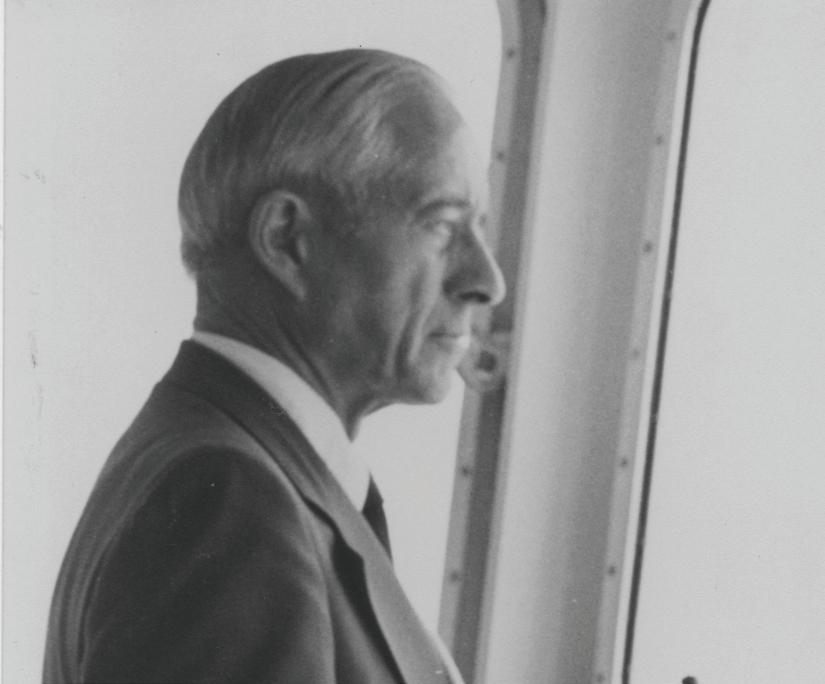




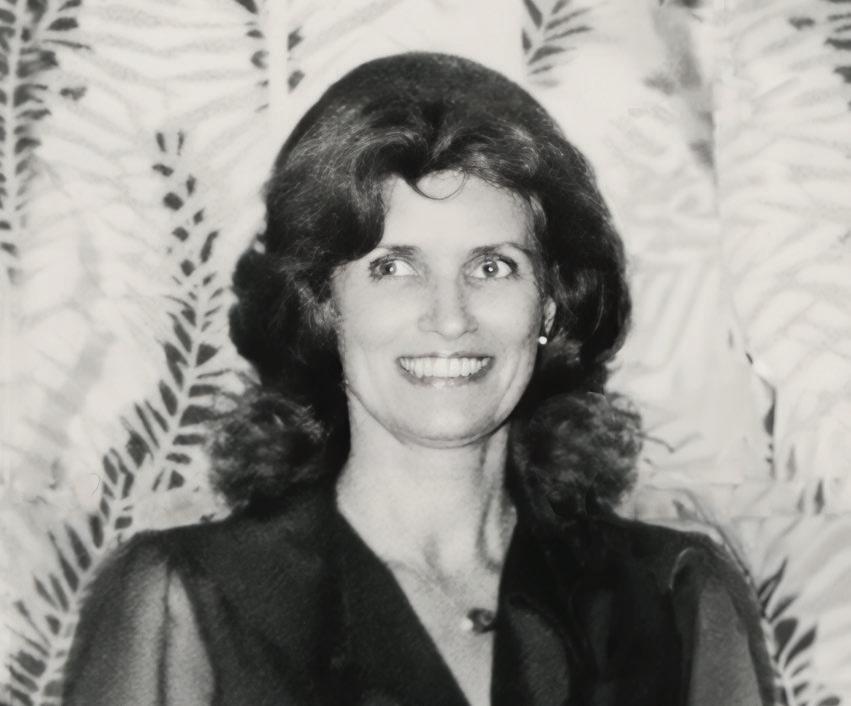

 Captain Ken Graham Ken was hired on in 1977 as a Pilot and promoted to serve the company as a Vice President. He retired in 1996.
Beverley Workman
Beverly came on board in 1966 and managed all the books and financial recording for 33 years.
Captain John Albright
John was hired on in 1969 as a Pilot and went on to lead the company as a Vice President. He retired in 1983.
Ramona Merle
Ramona was the first hire in 1940 and managed JPS finances for 44 years until her retirement in 1984.
Captain John Strong
John was hired as a Pilot in 1982 and rose to the rank of Vice President. He retired in 2022 with 40 years of service.
Nancy Brennan
Nancy was hired as our first CFO in 1990 and has managed JPS finances for 34 years.
Captain Mark Coynes Mark was hired on in 2001 as a Pilot and currently serves as Vice President.
Cynthia Alejandro
Captain Ken Graham Ken was hired on in 1977 as a Pilot and promoted to serve the company as a Vice President. He retired in 1996.
Beverley Workman
Beverly came on board in 1966 and managed all the books and financial recording for 33 years.
Captain John Albright
John was hired on in 1969 as a Pilot and went on to lead the company as a Vice President. He retired in 1983.
Ramona Merle
Ramona was the first hire in 1940 and managed JPS finances for 44 years until her retirement in 1984.
Captain John Strong
John was hired as a Pilot in 1982 and rose to the rank of Vice President. He retired in 2022 with 40 years of service.
Nancy Brennan
Nancy was hired as our first CFO in 1990 and has managed JPS finances for 34 years.
Captain Mark Coynes Mark was hired on in 2001 as a Pilot and currently serves as Vice President.
Cynthia Alejandro
49
Cynthia was hired in 2019 as our second CFO and also manages the day-to-day financials.
ALL EMPLOYEES ARE FAMILY
For 100 years, the backbone and heartbeat of Jacobsen Pilot Service has been our people. Our achievements are not just measured by vessel size or TEUs; they are the result of ingenuity, dedication, and hard work by a collection of remarkable individuals who have come together as a team—as a family. Their continuous commitment, passion, and resilience are why JPS has navigated countless challenges so successfully over the years. They are the embodiment of the command—“Steady As She Goes.”



CHAPTER 7
Dick and Jake present Captain Carl Aultman with a clock barometer plaque at his retirement in 1968 after 24 years of service. He was hired on as a Senior Pilot in 1944 and personally Piloted more than 14,000 ships to their berths with no incidents.
Captain Vic Schisler disembarks a ship. He retired after 40 years at JPS.
50
Captain Tom Clark at the ladder in 1990. His son, Shawn Clark, is now a JPS Pilot.










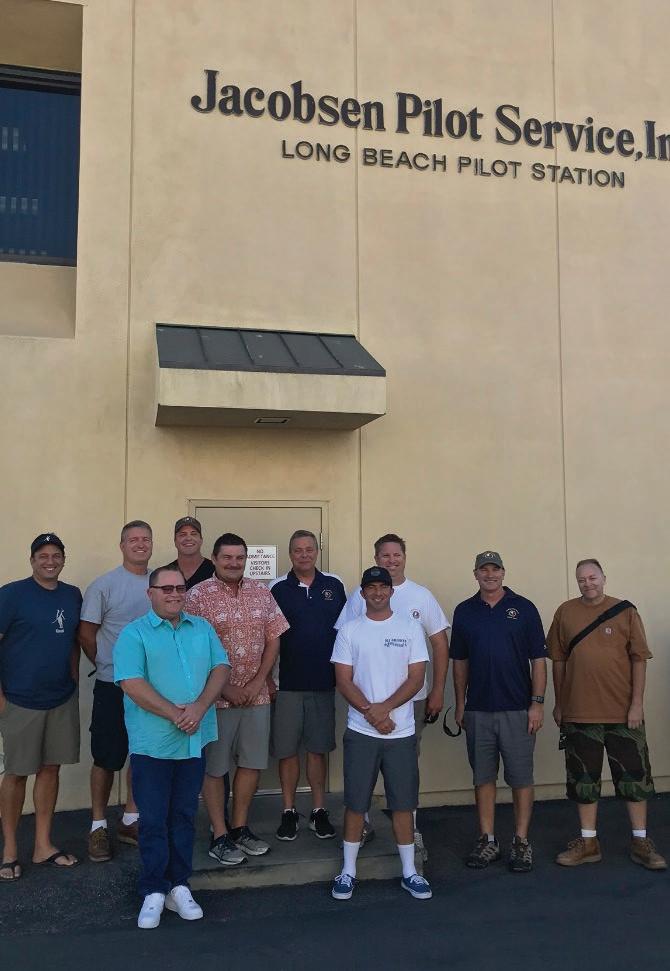





51
Loading the Sea Launch Odyssey. Captain Art Grant and JPS Team with LT CMDR Mahar.
1982. John Hebert, Chief Boatman, with John Glacklin, Gary Haldeman, Pat Conklin, and Chris Mueller.
Captain Bob Blair and Chief Boatman Dan Kennedy.
Pilots for the MSC TEXAS job. Captain’s Strong, Reid, Grant, Livingstone, Lukowski, and Levinson.
Captains Simon Cail, Rob Lukowski, and Bob Blair.
Thanksgiving feast for employees and families,.catered by Slavkos Harbor Poultry in San Pedro.
Pilot trainees and significant others at JPS employee retirement party in 2022.
Captain Mark Coynes and Galen Giebler.
Boatmen and Dispatchers at JPS event, 2022.
Boatman David Branch headed to the Sea Buoy.
Captain John Strong and Chris Halsted.
JPS hosts the Board of Directors Meeting at the Pilot Station in February 2024.
Captains Morley Ness, Mike Hewitt, and Art Grant, with Boatman Rob Tinsley.
Boatman, Ryan Gengler, delivering JPS Pilots to ships on the Pilot Boat.
Captains Grant Livingstone, John Strong, and Tom Jacobsen.
Captains Mark Coynes and Alan Reid.
A DAY IN THE LIFE OF A JPS PILOT
Talk to a JPS Pilot and you will inevitably hear these words: “I have the best job in the world.”

It takes a certain type of person to be a Jacobsen Pilot. The search for those who are both technically qualified and temperamentally suited is ongoing, with potential candidates identified by JPS management years in advance—often before they are even aware of being considered for the job. Once hired, the training period lasts approximately three years, during which there is no room for “having a bad day”. Among the most demanding jobs in the world, huge pressure is placed on each Pilot to ensure the safe passage of every inbound and outbound vessel.
The Port of Long Beach is open 365 days a year, 24 hours a day, nonstop, with no fixed schedule of arrivals and departures. Ships come and go at all hours, day and night. And each one must be guided by a JPS Pilot. There are currently 23 JPS Pilots. At any one time, half are on duty. The schedule is one week on/one week off. During a typical week, a Pilot might guide 20–25 vessels. The Pilot Station is a home away from home for JPS Pilots and includes a bunk house and kitchen so they can rest and refuel while awaiting the Dispatcher’s call.
The actual job begins and ends at the Pilot Station. The crew of an inbound or outbound vessel radios
JPS Dispatch to request a Pilot. At the Pilot Station, the Dispatcher assigns one of the specialized, highspeed JPS Pilot Boats to take each Pilot out to meet their assigned vessel. Once that vessel is on course, the JPS Pilot Boat approaches. This is the critical moment. The Pilot goes up on deck and places the “Nav bag” on the platform. Then, once the Pilot Boat is directly alongside the ship and stable, the JPS Pilot carefully transitions to the ship’s ladder and begins the long climb. The Boat Operator is acutely aware of the inherent dangers of the Pilot’s climb and the Pilot Boat remains in place until the Pilot’s safe ascent is complete.

52
JPS Captains Vincent, Kendricks, Koehler, Common, and Rogers.
CHAPTER 8
Captain Lenny Lopez.



Once the JPS Pilot boards the vessel, a second climb begins, this time up to the ship’s bridge. Greeting the Captain and Bridge Team, there’s an exchange of essential information: What is the ship’s power and speed? How deep is the draft? Is all the ship’s equipment working properly? With Captains and crews of all nationalities aboard, a simple discussion isn’t always so simple, but once the information is exchanged, the JPS Pilot takes navigational control of the ship. Each vessel is unique, with different inputs both visually and electronically. Even among vessel types, the variables are endless: length, height, beam, propulsion type, keel design, and draft.
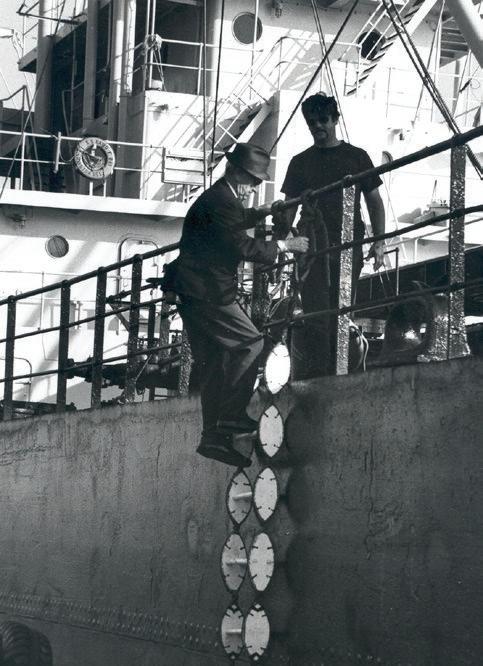

JPS Pilots must assimilate all that information and factor it all against Nature’s own variables: wind, waves, current, and tide. The other key part of Piloting is local knowledge, the literal “ins and outs” of the Port of Long Beach with critical concern for unseen obstacles, obstructions, or hazards below the water.
JPS has spearheaded developing Pilot navigation technology throughout its history. The presentday Portable Pilot Units (PPU) are handheld tablet computers that receive RTK GPS positioning and display a ship’s position icon, overlaid on a highresolution digital chart. With the PPU, the Pilot has the ship’s exact position in relation to the shoreline, piers, channels, underwater obstructions, and other vessels, either moving or docked. With the ship’s heading accurate to a fraction of a degree, Pilots can see where the ship is projected to move in the next minute, two minutes, and three minutes. With megaships now 1,300 feet long and containers stacked so high that they block the Pilot’s view of the channel, the PPUs are essential to safe navigation.



53
1966: Pilot Larry Edwards 1956: Boatman Ed Gorman
Capt. Brian Deedler
Capt. Larry Hoyne
Capt. Art Grant
Capt. Rob Gessner
Captains Jason Harju and Mitch Hetterle
Captains Rob Gessner and Nick Deuel
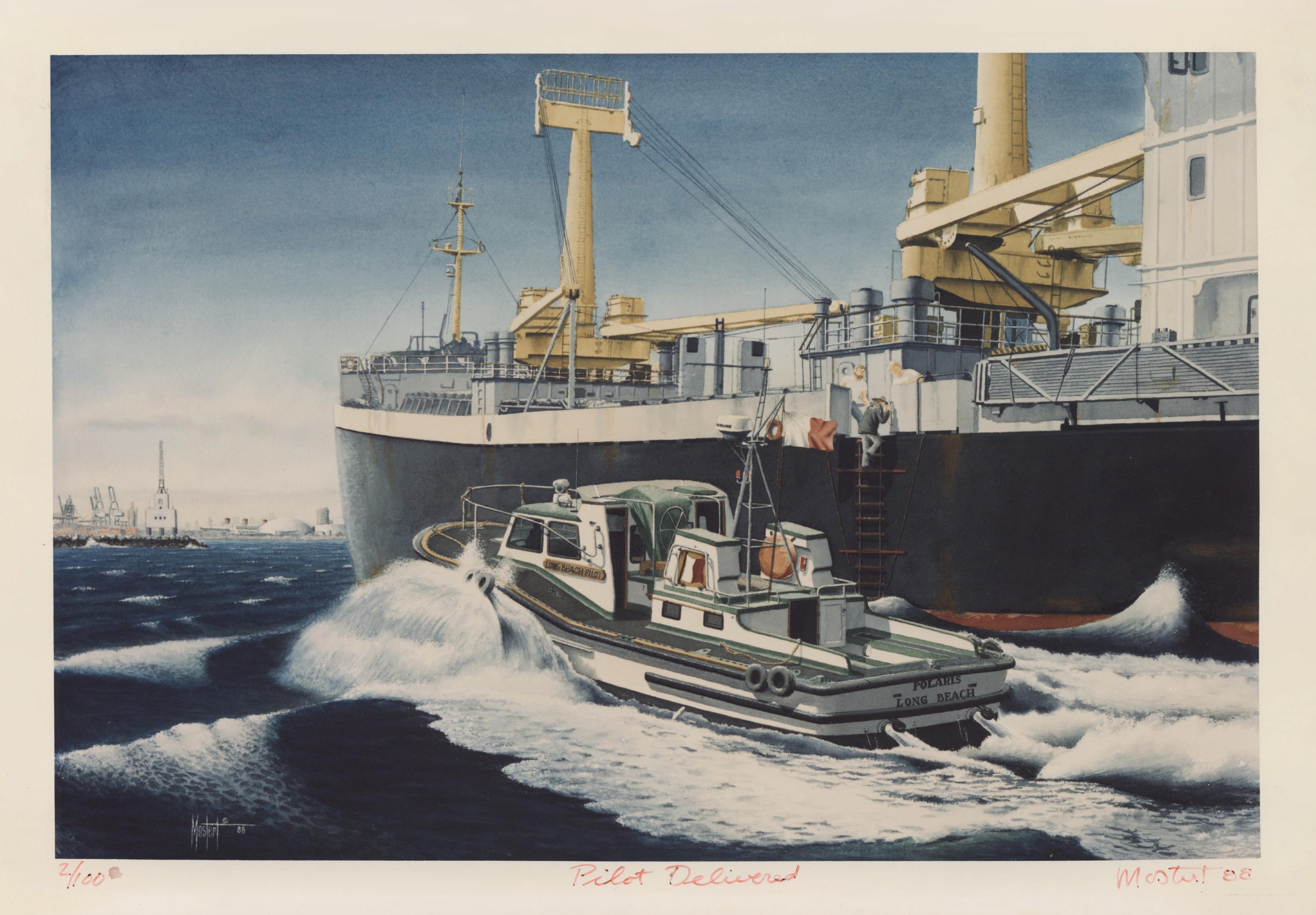

OUR FLAGSHIPS ARE SMALL BUT MIGHTY
Designed to be agile, efficient, and safe, the JPS Pilot Boats are a floating metaphor for the company.
Flying from each boat is a white and red flag, which is a signal flag for “H,” meaning “Pilot.” However, on the trip from the station to the ship, the JPS Pilot is merely a passenger.
Driving each JPS Pilot Boat is an experienced Boat Operator born with the nerves of steel it takes to command a 60-foot vessel surrounded by the leviathans of global shipping. Maneuvering into position alongside container ships and oil tankers up to 1,300 feet in length, the contrast in scale is stunning. JPS Boat Operators must skillfully time the approach, perfectly matching speeds of approximately 8–10 knots to bring the JPS Pilot Boat in sync with the larger vessel. Only then can the JPS Pilot prepare to transfer up the ship’s ladder.
The latest JPS Pilot Boats are the Orion and Polaris III; both 63-foot vessels built by Nordland Boat Company and powered by HM521 Hamilton Jets. Quieter and smoother than propeller-driven boats, the jets also make the Pilot Boat incredibly agile. Any maneuver the Boat Operator desires,
including being able to “walk” the boat sideways, is now possible. The new Nordland-built boats were designed by naval architect Tim Nolan, with input from JPS Boat Operators and maintenance crew. The boats are now easier to maintain, as all equipment and electronics are readily accessible. They’re more energy efficient, too, cutting carbon emissions to help meet the Green Port initiatives.
The interior includes adjustable seats that provide the Pilots with state-of-the-art ergonomic comfort and support. Noise levels are now significantly reduced compared with older Pilot Boats. The high-visibility yellow paint scheme helps identify the boats in all weather conditions. And in the event of a “man overboard” situation, a hydraulic lift retrieval system can quickly deploy and help JPS Boat Operators rescue someone in the water.

CHAPTER 9 55
HISTORY OF OUR PILOT BOATS




Purchased to accommodate the U.S. Navy and the Naval Shipyard.
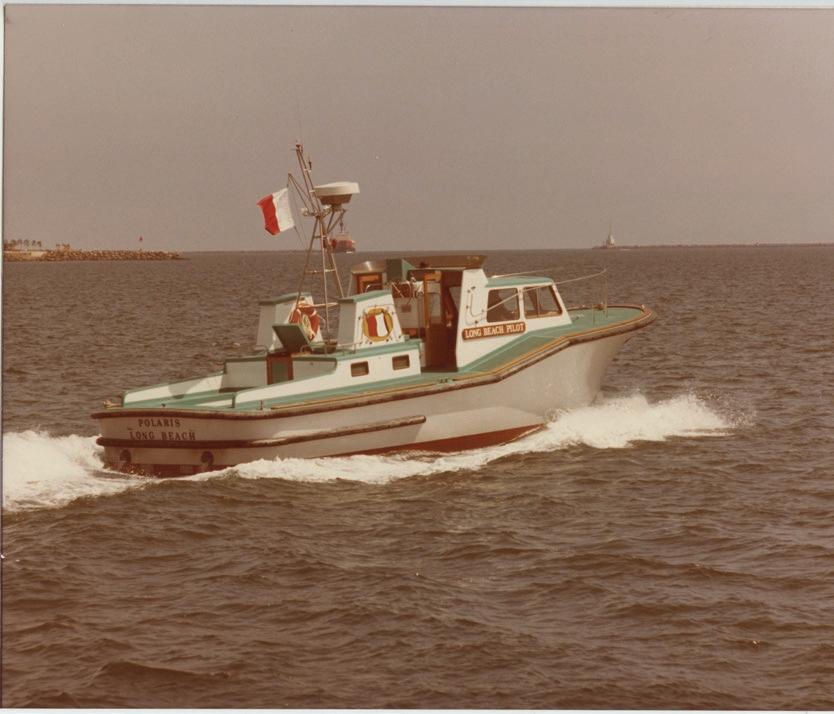
During WWII additional Pilots and a Pilot Boat were added.

A new hull was built by Delta Marine in Seattle, WA. and the additional core components of the boat were completed locally.
A new aluminum Pilot Boat is built in Canada at Hike Metals. 54 feet in length, it has a speed of 30 knots and a Chine Hull.
The wheelhouses of both Pilot Boats are upgraded and enclosed.
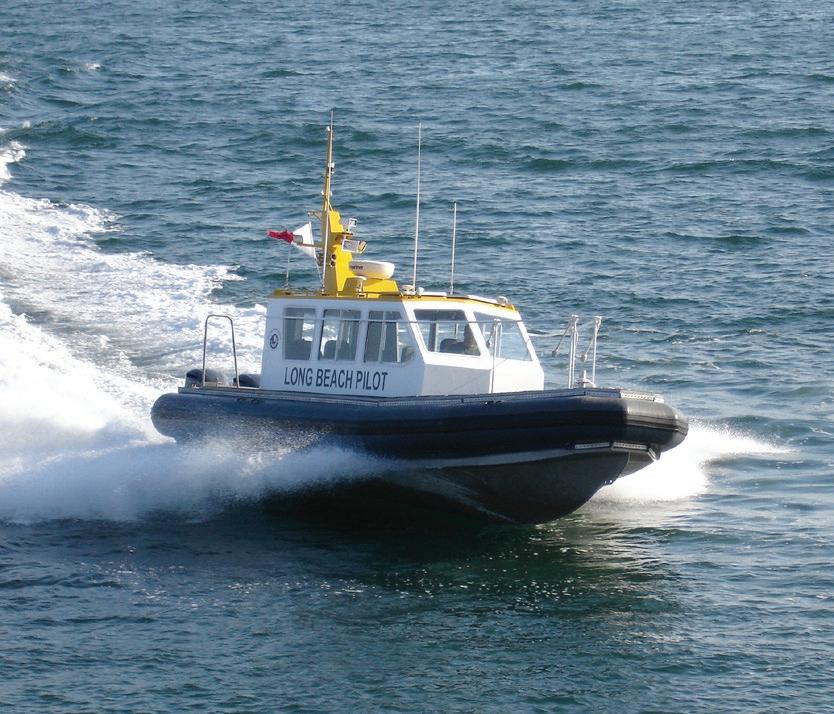

Built to meet the air quality goals of the San Pedro Bay Ports Clean Air Action plan, and in 2010 earns the port’s Clean Air Award.
Two new boats built by Nordlund Boat Co. in Tacoma, WA. are powered by jet drive for improved safety and maneuverability.
56
1943: Vega
2002: Vega
1940: Polaris I
1977: Polaris II
1960: Polaris and Vega
2006: Altair
1973: Venus launch “Dick” Jacobsen finalises the paperwork before putting the Venus to work.
2022: Orion and Polaris III

57 Captain Art Grant
BUILDING NEW PILOT BOATS

Handmade illustrations of concept model drawn by Tim Nolan.




CAD generated rendering for approvals of design. Selecting exterior color schematic.




58
3D rendering of simulated boat.
Wood mock-up of helm built at JPS in the garage.
Team working on layout of instrumentation.
Adam Barry, Paul Nordland, Tom Jacobsen, and Dan Kennedy. Tim Nolan, Tom Jacobsen, Paul and Gary Nordland.
Michele Jacobsen christens the Orion our new Pilot Boat.
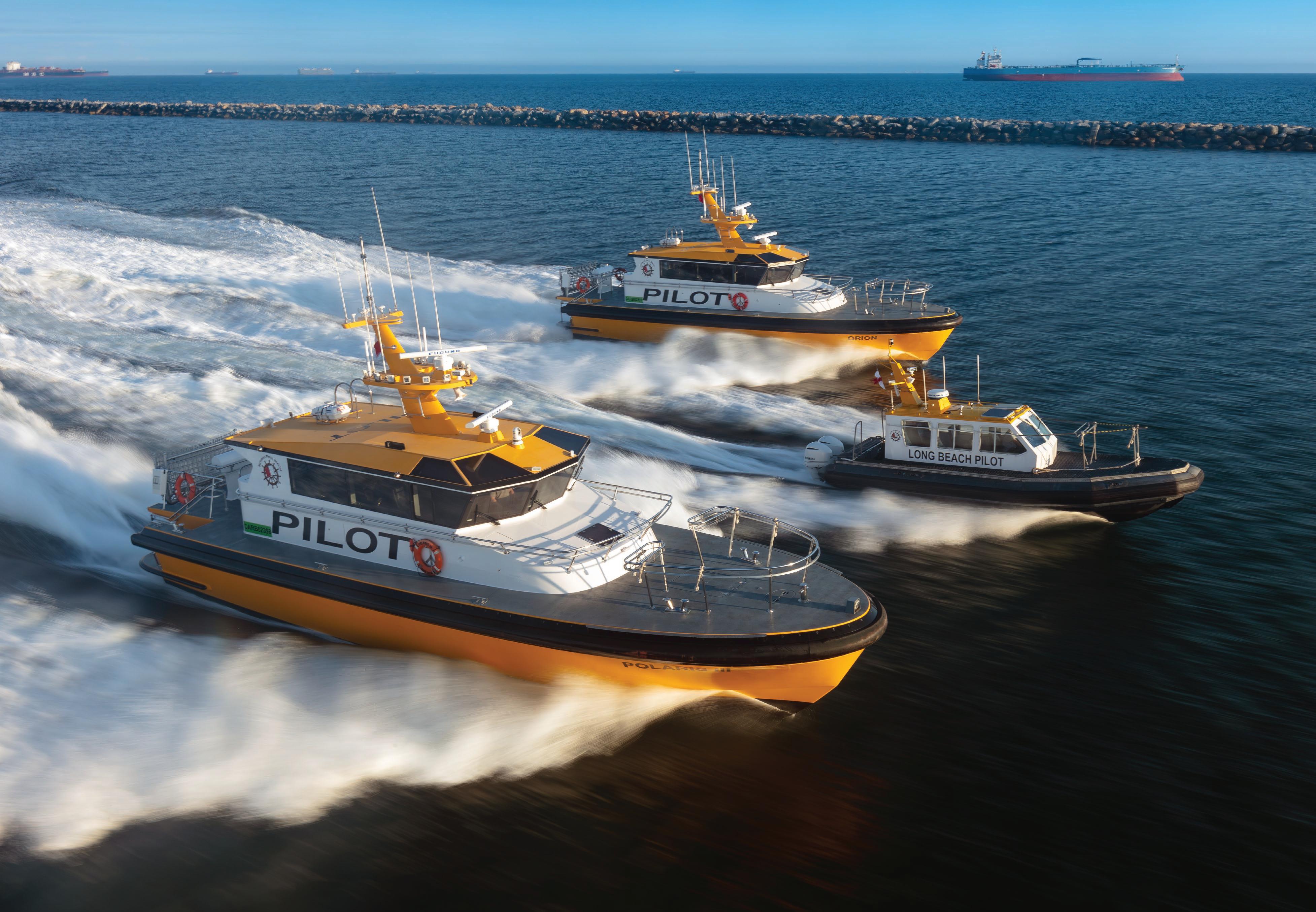
59

THE NEXT YEARS
Our future course is guided by our planning for the expected—and, more important, for the unexpected.
Throughout its history, JPS has partnered with the Port of Long Beach to prepare for changes in the maritime industry. That collaboration helped Long Beach grow into one of the world’s busiest commercial harbors—and how it continues to win new business against fierce competition from other West Coast ports. Moving forward, the Port and JPS expect continued growth in cargo volumes, with some projections showing that the San Pedro Bay could handle 40 million TEUs annually by 2040—doubling the current volume. To do that with no bottlenecks or congestion, a major expansion will be required to both the Port’s infrastructure and to the connecting
rail and road transportation networks. Technology will play a huge part in making it possible to meet these ambitious goals. Recent breakthroughs in Artificial Intelligence, data analytics, and automation are rapidly impacting industries across the globe. For maritime shipping, these three factors promise to radically improve the efficiency of cargo handling, inventory logistics, and operational safety, while helping to cut carbon emissions to meet the goal of a zero-emission terminal by 2030.
Cleaner technologies, renewable energy sources, and eco-friendly practices to reduce the Port’s carbon footprint are all part of a larger solution to
the complex challenge of sustainability. That is just some of what’s expected—but plans are also being made for what’s less certain. As the COVID pandemic demonstrated, global trade patterns and supply chains can be suddenly and profoundly altered. Economic shifts can be seismic, triggered by changing geopolitical events, new security threats, or environmental disasters.
But there’s reassurance in knowing this is a company that navigated safely through the Great Depression in 1929, the Long Beach Earthquake of 1933, World War II, and other crises. JPS is ready for whatever the coming decades bring.
CHAPTER 10 60

New Long Beach Container Terminal.
175 shipping lines now connect Long Beach to 217 seaports, making possible $200b in trade annually. To help tackle increased shipping traffic, the recent completion of the Long Beach Container Terminal (LBCT) creates one of the most advanced cargo facilities in the world.
2024
2024–2026
Seal Beach Ammunition Pier Replacement Project.
The primary mission of the Naval Weapons Station in Seal Beach is to load munitions and weapons. The new pier will be able to service larger Naval vessels and provide a safer and more efficient operation.


POLB Proposes Pier Wind Project Concept.
400 acres of landfill to create a new terminal, located south of Terminal Island Navy Mole in the Bravo Anchorages. The proposed Pier Wind Terminal will facilitate the construction of wind turbines, which will be towed up the California Coast and anchored in strategic locations to facilitate the State in reaching its renewable energy targets. Standing more than 1,000 feet tall, the turbines would produce 25 gigawatts of offshore wind power in the coming decades.
2024–2031

40 million TEU forecast.
The San Pedro Bay ports could move as many as 40 million containers annually by the year 2040. That’s nearly double the record set in 2021—the Ports’ busiest year ever. Our challenge is help reduce congestion and be efficient in managing wait times.
2024–2035 2040 2024–2032

New Pier B On-Dock Rail Support Facility.
Currently, about 20% of cargo is transported via on-dock rail. The goal is to boost on-dock rail use to 35%. This new facility will dramatically streamline rail operations by allowing longer trains to be assembled with greater frequency and minimizing the increase in truck trips as cargo volume grows. The new facility will more than double the size of the existing Pier B rail yard and more than triple the volume of on-dock rail cargo the Port can handle annually, to 4.7 million TEUs.
The future of the maritime industry. Jacobsen Pilot Service will be ready to meet the challenges of future demands. Cargo will remain to be transported around the world by conventional or autonomous ships, and these ships will need professional Pilots to ensure they are moved efficiently, and safely to protect the port and our environment. At JPS we will continue to provide our exceptional Piloting Services as we have done for 100 years.
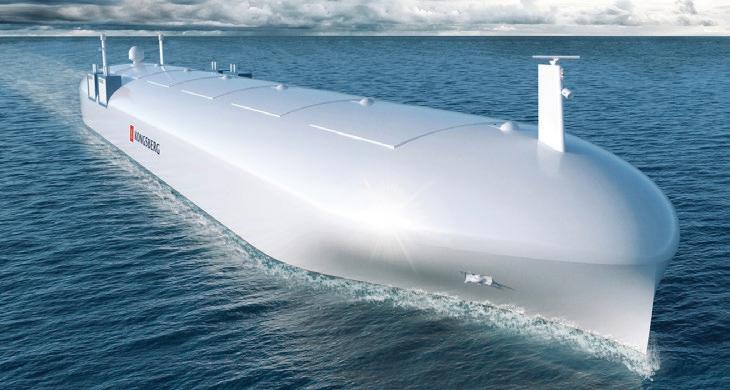
61
Photo credit: Kongsberg Maritime AS.
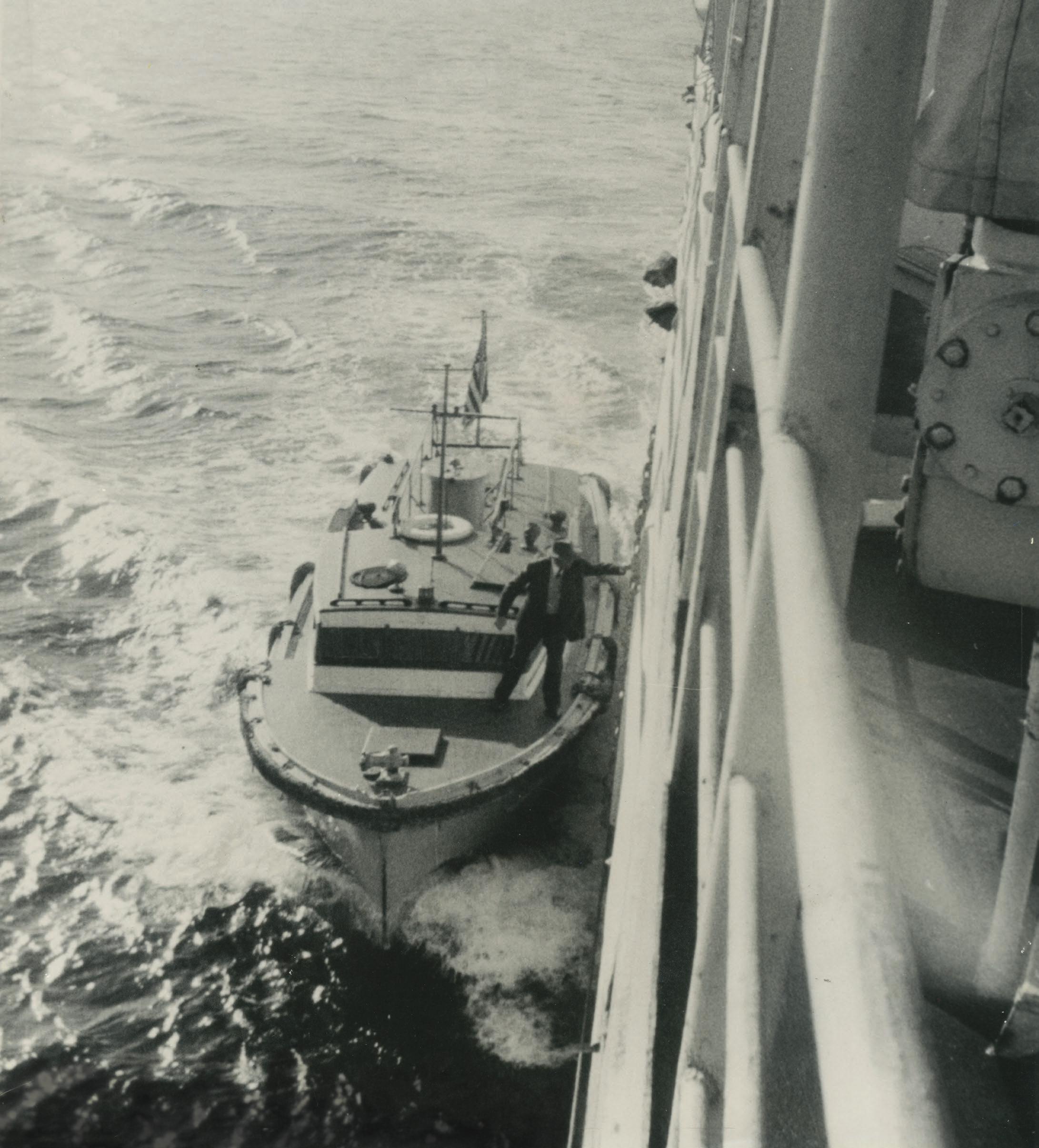
“Both
my grandfather and my father would be especially proud that the high standards of professionalism and service to the customer, established decades ago are upheld by everyone in our company today.”
62
Captain J.A. Jacobsen boarding the training ship Golden Bear in 1950.
LETTER OF APPRECIATION
I have thoroughly enjoyed watching this book come together and looking back on the 100-year history of our family company.
It continues to amaze me how my grandfather’s work ethic and dedication allowed him to start his own business in the Port of Long Beach—the “mudflats”—where he Piloted only a few ships a month in that first year of 1924. Starting out was extremely hard for him—and it only got more challenging through the Great Depression and WWII. Nothing was easy in those days.
He would be amazed to see us today, Piloting 7,000 ships per year—many of them among the largest in the world.
Both my grandfather and father would be especially proud that the high standards of professionalism and service to the customer, established decades ago, are upheld by everyone in our company today. In the maritime industry, JPS employees continue to be highly regarded as among the most professional of any Pilot organization.
I want to thank all of you at Jacobsen Pilot Service for carrying on this tradition of excellence and keeping ships moving safely and efficiently through the Port of Long Beach. The JPS team we have—and have always had—is exceptional.
This is why we are successful and can celebrate our 100th year of service. I look forward to our future together.
Sincerely,
Thomas A. Jacobsen
63

This book would not be possible without our talented
3
team: Ron Hirt—publisher | Tim Rue—photography | Rich Conklin—writer | David Matea—design | Sandra Jacobsen—contributor and final edits.

















































































 Dispatcher Troy Waters.
Dispatcher Troy Waters.
























































 Captain Ken Graham Ken was hired on in 1977 as a Pilot and promoted to serve the company as a Vice President. He retired in 1996.
Beverley Workman
Beverly came on board in 1966 and managed all the books and financial recording for 33 years.
Captain John Albright
John was hired on in 1969 as a Pilot and went on to lead the company as a Vice President. He retired in 1983.
Ramona Merle
Ramona was the first hire in 1940 and managed JPS finances for 44 years until her retirement in 1984.
Captain John Strong
John was hired as a Pilot in 1982 and rose to the rank of Vice President. He retired in 2022 with 40 years of service.
Nancy Brennan
Nancy was hired as our first CFO in 1990 and has managed JPS finances for 34 years.
Captain Mark Coynes Mark was hired on in 2001 as a Pilot and currently serves as Vice President.
Cynthia Alejandro
Captain Ken Graham Ken was hired on in 1977 as a Pilot and promoted to serve the company as a Vice President. He retired in 1996.
Beverley Workman
Beverly came on board in 1966 and managed all the books and financial recording for 33 years.
Captain John Albright
John was hired on in 1969 as a Pilot and went on to lead the company as a Vice President. He retired in 1983.
Ramona Merle
Ramona was the first hire in 1940 and managed JPS finances for 44 years until her retirement in 1984.
Captain John Strong
John was hired as a Pilot in 1982 and rose to the rank of Vice President. He retired in 2022 with 40 years of service.
Nancy Brennan
Nancy was hired as our first CFO in 1990 and has managed JPS finances for 34 years.
Captain Mark Coynes Mark was hired on in 2001 as a Pilot and currently serves as Vice President.
Cynthia Alejandro



























































